HARRIS TR-396-A2 GSM Portable Terminal User Manual Exhibit 8
HARRIS CORPORATION GSM Portable Terminal Exhibit 8
HARRIS >
Exhibit 8

Register your new phone, purchase Ericsson original accessories, and see the latest in products by visiting us at:
www.ericsson.com/us/consumer
X/99 PBM
This manual is published by Ericsson Inc., without any warranty. Improvements and changes to this manual necessitated by typographical
errors, inaccuracies of current information, or improvements to programs and/or equipment, may be made by Ericsson Inc., at anytime and
without notice. Such changes will, however, be incorporated into new editions of this manual.
All rights reserved.
Ericsson Inc., 1999.
Publication Number: LZT 123 1422 PA4
Printed in the U.S.A.
T18z User’s Guide

Some menus/features are operator dependent.
1
Guidelines for Safe and Efficient Use . . . . . 5
Safety . . . . . . . . . . . . . . . . . . . . . . . . . . . . . . . . . . . . . . . . .5
Driving . . . . . . . . . . . . . . . . . . . . . . . . . . . . . . . . . . . . . . .7
Phone Care and Operation . . . . . . . . . . . . . . . . . . . . . . . .7
Battery Information . . . . . . . . . . . . . . . . . . . . . . . . . . . . . .8
Preparing Your Phone for Use . . . . . . . . . . 10
T18z Components . . . . . . . . . . . . . . . . . . . . . . . . . . . . . .10
Assembly . . . . . . . . . . . . . . . . . . . . . . . . . . . . . . . . . . . . .10
The SIM Card . . . . . . . . . . . . . . . . . . . . . . . . . . . . . . . . .10
The Battery . . . . . . . . . . . . . . . . . . . . . . . . . . . . . . . . . . .11
The Display, Keys, and Menus . . . . . . . . . . 13
Turning Your Phone On/Off . . . . . . . . . . . . . . . . . . . . .13
Display Messages . . . . . . . . . . . . . . . . . . . . . . . . . . . . . . .13
Display Icons . . . . . . . . . . . . . . . . . . . . . . . . . . . . . . . . . .14
Key Functions . . . . . . . . . . . . . . . . . . . . . . . . . . . . . . . . .15
Active Flip . . . . . . . . . . . . . . . . . . . . . . . . . . . . . . . . . . . .15
Navigating the Menu System . . . . . . . . . . . . . . . . . . . . . .16
Making and Receiving Calls . . . . . . . . . . . . 18
Making a Call . . . . . . . . . . . . . . . . . . . . . . . . . . . . . . . . .18
Ending a Call . . . . . . . . . . . . . . . . . . . . . . . . . . . . . . . . . .19
Making International Calls . . . . . . . . . . . . . . . . . . . . . . 19
Making Emergency Calls . . . . . . . . . . . . . . . . . . . . . . . . 19
Receiving Calls . . . . . . . . . . . . . . . . . . . . . . . . . . . . . . . . 19
During a Call . . . . . . . . . . . . . . . . . . . . . . . . . . . . . . . . . 20
Your Phone Book . . . . . . . . . . . . . . . . . . . . 22
Entering Characters . . . . . . . . . . . . . . . . . . . . . . . . . . . . 22
Storing a Number Together with a Name . . . . . . . . . . . 23
Overwrite Protection . . . . . . . . . . . . . . . . . . . . . . . . . . . 24
Using the Phone Book . . . . . . . . . . . . . . . . . . . . . . . . . . 25
Keeping the Phone Book Up to Date . . . . . . . . . . . . . . . 25
Copying Phone Numbers Between Memories . . . . . . . . 26
Using the Call List . . . . . . . . . . . . . . . . . . . . . . . . . . . . . 27
Calling Line Identification (CLI) . . . . . . . . . . . . . . . . . . 28
Personalizing Your Phone . . . . . . . . . . . . . 30
Ring Signal Volume . . . . . . . . . . . . . . . . . . . . . . . . . . . . 30
Ring Signal Type . . . . . . . . . . . . . . . . . . . . . . . . . . . . . . 30
Your Own Ring Signals . . . . . . . . . . . . . . . . . . . . . . . . . 32
Vibrating Unit . . . . . . . . . . . . . . . . . . . . . . . . . . . . . . . . 32
Minute Minder . . . . . . . . . . . . . . . . . . . . . . . . . . . . . . . 32
Message Signal . . . . . . . . . . . . . . . . . . . . . . . . . . . . . . . . 33
Key Sound . . . . . . . . . . . . . . . . . . . . . . . . . . . . . . . . . . . 33
Table of Contents
Some menus/features are operator dependent.
2
Display Light . . . . . . . . . . . . . . . . . . . . . . . . . . . . . . . . . 33
Display Language . . . . . . . . . . . . . . . . . . . . . . . . . . . . . . 33
Greeting Text . . . . . . . . . . . . . . . . . . . . . . . . . . . . . . . . . 33
Phone Number Display . . . . . . . . . . . . . . . . . . . . . . . . . 34
Time . . . . . . . . . . . . . . . . . . . . . . . . . . . . . . . . . . . . . . . . 34
Date . . . . . . . . . . . . . . . . . . . . . . . . . . . . . . . . . . . . . . . . 35
Auto Store . . . . . . . . . . . . . . . . . . . . . . . . . . . . . . . . . . . 35
Master Reset . . . . . . . . . . . . . . . . . . . . . . . . . . . . . . . . . . 35
Mail Services . . . . . . . . . . . . . . . . . . . . . . . . 37
Short Message Service . . . . . . . . . . . . . . . . . . . . . . . . . . . 37
Enabling the Phone to Send SMS . . . . . . . . . . . . . . . . . . 37
Enhancing Your Text Messages . . . . . . . . . . . . . . . . . . . 37
Composing a Text Message . . . . . . . . . . . . . . . . . . . . . . 38
Sending a New Text Message . . . . . . . . . . . . . . . . . . . . . 38
Sending a Stored Message . . . . . . . . . . . . . . . . . . . . . . . . 39
Receiving a Message . . . . . . . . . . . . . . . . . . . . . . . . . . . . 39
Reading a Stored Message . . . . . . . . . . . . . . . . . . . . . . . . 40
Replying to a Message . . . . . . . . . . . . . . . . . . . . . . . . . . . 41
Erasing a Message . . . . . . . . . . . . . . . . . . . . . . . . . . . . . . 41
Storing Incoming Messages . . . . . . . . . . . . . . . . . . . . . . . 41
Own Messages . . . . . . . . . . . . . . . . . . . . . . . . . . . . . . . . 42
Area Information . . . . . . . . . . . . . . . . . . . . . . . . . . . . . . 43
Voicemail . . . . . . . . . . . . . . . . . . . . . . . . . . . . . . . . . . . . 45
Forwarding Calls . . . . . . . . . . . . . . . . . . . . . 46
Activating Call Forward . . . . . . . . . . . . . . . . . . . . . . . . . 46
Forwarding When the Data Menus are On . . . . . . . . . . . 46
Checking the Forward Status . . . . . . . . . . . . . . . . . . . . . 47
Canceling Call Forwards . . . . . . . . . . . . . . . . . . . . . . . . . 47
Canceling All Call Forwards . . . . . . . . . . . . . . . . . . . . . . 47
Security . . . . . . . . . . . . . . . . . . . . . . . . . . . . 48
Keypad Lock . . . . . . . . . . . . . . . . . . . . . . . . . . . . . . . . . . 48
The SIM Card Lock . . . . . . . . . . . . . . . . . . . . . . . . . . . . 48
Phone Lock . . . . . . . . . . . . . . . . . . . . . . . . . . . . . . . . . . . 50
Call Restrict . . . . . . . . . . . . . . . . . . . . . . . . . . . . . . . . . . 50
Fixed Dialing . . . . . . . . . . . . . . . . . . . . . . . . . . . . . . . . . 51
Closed User Groups . . . . . . . . . . . . . . . . . . . . . . . . . . . . 52
Handling Multiple Calls. . . . . . . . . . . . . . . . 54
Call Waiting Service . . . . . . . . . . . . . . . . . . . . . . . . . . . . 54
Making a Second Call While a Call is in Progress . . . . . . 54
Receiving a Second Call . . . . . . . . . . . . . . . . . . . . . . . . . 54
Receiving a Third Call . . . . . . . . . . . . . . . . . . . . . . . . . . 55
Conference Calls . . . . . . . . . . . . . . . . . . . . . . . . . . . . . . . 56
Networks . . . . . . . . . . . . . . . . . . . . . . . . . . . 58
Searching for Networks . . . . . . . . . . . . . . . . . . . . . . . . . . 58
Selecting a New Network . . . . . . . . . . . . . . . . . . . . . . . . 58
List of Forbidden Networks . . . . . . . . . . . . . . . . . . . . . . 59
Some menus/features are operator dependent.
3
List of Preferred Networks . . . . . . . . . . . . . . . . . . . . . . . .59
Search Modes . . . . . . . . . . . . . . . . . . . . . . . . . . . . . . . . .60
Voice Activation. . . . . . . . . . . . . . . . . . . . . . 61
Recording Voice Dialing Labels . . . . . . . . . . . . . . . . . . . .61
Replacing a Voice Dialing Label . . . . . . . . . . . . . . . . . . .62
Erasing a Voice Dialing Label . . . . . . . . . . . . . . . . . . . . .63
Voice Label List . . . . . . . . . . . . . . . . . . . . . . . . . . . . . . . .63
Using Voice Dialing . . . . . . . . . . . . . . . . . . . . . . . . . . . .63
Recording the Voice Answering Labels . . . . . . . . . . . . . .64
Replacing the Voice Answering Labels . . . . . . . . . . . . . . .64
Answering or Rejecting a Call Using Voice Activation . . .64
Extra Features . . . . . . . . . . . . . . . . . . . . . . . 65
Call Time and Call Cost . . . . . . . . . . . . . . . . . . . . . . . . .65
Credit Limit for Calls . . . . . . . . . . . . . . . . . . . . . . . . . . .66
Calling Card or Credit Card Calls . . . . . . . . . . . . . . . . . .66
Editing or Deleting a Calling Card Number . . . . . . . . . .68
Using Two Voice Lines . . . . . . . . . . . . . . . . . . . . . . . . . .68
Calling from Your Car . . . . . . . . . . . . . . . . . . . . . . . . . . .69
Handsfree Types . . . . . . . . . . . . . . . . . . . . . . . . . . . . . . .69
Answering Mode . . . . . . . . . . . . . . . . . . . . . . . . . . . . . . .70
Sending and Receiving Faxes and Data . . . . . . . . . . . . . .70
Activating the Data Menus . . . . . . . . . . . . . . . . . . . . . . .70
Next Call Type . . . . . . . . . . . . . . . . . . . . . . . . . . . . . . . .71
Alarm . . . . . . . . . . . . . . . . . . . . . . . . . . . . . . . . . . . . . . .71
Calculator . . . . . . . . . . . . . . . . . . . . . . . . . . . . . . . . . . . 71
Quick Keys . . . . . . . . . . . . . . . . . . . . . . . . . . . . . . . . . . 72
Troubleshooting . . . . . . . . . . . . . . . . . . . . . 74
Error Messages . . . . . . . . . . . . . . . . . . . . . . . . . . . . . . . . 74
Phone Does not Come On . . . . . . . . . . . . . . . . . . . . . . 75
Poor Sound Quality in Handsfree Equipment . . . . . . . . 75
Voice Answering Does Not Perform Well . . . . . . . . . . . 75
Voice Recording Problems . . . . . . . . . . . . . . . . . . . . . . . 75
Technical Support . . . . . . . . . . . . . . . . . . . . . . . . . . . . . 75
Terminology. . . . . . . . . . . . . . . . . . . . . . . . . 76
Acronym List . . . . . . . . . . . . . . . . . . . . . . . . . . . . . . . . . 76
Glossary . . . . . . . . . . . . . . . . . . . . . . . . . . . . . . . . . . . . . 76
Some menus/features are operator dependent.
4

.
Guidelines for Safe and Efficient Use 5
Since its introduction in the mid 1980s the mobile
phone is one of the most exciting and innovative
products ever developed. Your phone can help you to
stay in touch with your office, your home, emergency
services, and others.
Safety
Exposure to Radio Frequency Energy
Your wireless handheld portable telephone is a low
power radio transmitter and receiver. When it is ON,
it receives and also sends out radio frequency (RF)
signals.
In August, 1996, the Federal Communications Com-
mission (FCC) adopted RF exposure guidelines with
safety levels for handheld wireless phones. Those
guidelines are consistent with the safety standards pre-
viously set by both US and international standards
bodies:
•ANSI C95.1 (1992)*
•NCRP Report 86 (1986)*
•ICNIRP (1996)*
Those standards were based on comprehensive and
periodic evaluations of the relevant scientific litera-
ture. For example, over 120 scientists, engineers, and
physicians from universities, government health agen-
cies, and industry reviewed the available body of
research to develop the ANSI Standards (C95.1).
The design of your phone complies with the FCC
guidelines (and those standards).
* American National Standards Institute: National
Council on Radiation Protection and Measurements;
International Commission on Non-Ionizing Radiation
Protection.
Posted Facilities
Turn your phone OFF in any facility where posted
notices so require.
Aircraft
FCC regulations prohibit using your phone while in
the air. Switch OFF your phone before boarding an
aircraft.
Electronic Devices
Most modern electronic equipment, for example
equipment in hospitals and cars, is shielded from RF
energy. However, certain electronic equipment may
not be shielded against RF signals from your wireless
phone.
Guidelines for Safe and Efficient Use
6Guidelines for Safe and Efficient Use
Pacemakers
The Health Industry Manufacturers Association rec-
ommends that a minimum separation of six (6”)
inches be maintained between a handheld wireless
phone and a pacemaker to avoid potential interference
with the pacemaker. These recommendations are con-
sistent with the independent research by and recom-
mendations of Wireless Technology Research.
Persons with pacemakers:
•Should ALWAYS keep the phone more than six
inches from their pacemaker when the phone is
turned ON.
•Should not carry the phone in pockets (including
overcoat pockets) within 6” of the pacemaker
device.
•Should use the ear opposite the pacemaker to
minimize the potential for interference.
If you have any reason to suspect that interference is
taking place, turn your phone OFF immediately.
Hearing Aids
Some digital wireless phones may interfere with some
hearing aids. In the event of such interference, you
may want to consult your service provider (or call the
customer service line to discuss alternatives).
Other Medical Devices
If you use any other personal medical device, consult
the manufacturer of your device to determine if it is
adequately shielded from external RF energy. Your
physician may be able to assist you in obtaining this
information.
Turn your phone OFF in health care facilities when
any regulations posted in these areas instruct you to do
so. Hospitals or health care facilities may be using
equipment that could be sensitive to external RF
energy.
Children
Do not allow children to play with your phone. They
could hurt themselves or others, or could accidentally
damage the phone. Your phone contains small parts
that could be detached and create a choking hazard.
Blasting Areas
To avoid interfering with blasting operation, turn your
phone OFF when in a “blasting area” or in areas
posted: “Turn off two-way radio.” Obey all signs and
instructions.
Potentially Explosive Atmospheres
Turn your phone OFF when in any area with a poten-
tially explosive atmosphere and obey all signs and
instructions. Sparks in such areas could cause an
explosion or fire resulting in bodily injury or even
death.
Areas with a potentially explosive atmosphere are
often, but not always, clearly marked. They include
fuelling areas such as gasoline stations; below deck on
boats; fuel or chemical transfer or storage facilities;

.
Guidelines for Safe and Efficient Use 7
vehicles using liquefied petroleum gas (such as pro-
pane or butane); areas where the air contains chemi-
cals or particles, such as grain, dust, or metal powders;
and any other area where you would normally be
advised to turn off your vehicle engine.
Driving
Check the laws and regulations on the use of wireless
telephones in the areas where you drive. Always obey
them. Also, if using your phone while driving, please:
•Get to know your wireless phone and its features
such as speed dial and redial.
•When available, use a handsfree
device.
•Position your wireless phone
within easy reach.
•Suspend conversations during
hazardous driving conditions or
situations.
•Do not take notes or look up phone numbers
while driving.
•Dial sensibly and assess the traffic; if possible,
place calls when you are not moving or before
pulling into traffic.
•Do not engage in stressful or emotional conversa-
tions that may be distracting.
•Use your wireless phone to call for help.
•Use you wireless phone to help others in emer-
gencies.
•Call roadside assistance or a special wireless non-
emergency assistance number when necessary.
•Give full attention to driving.
•Pull off the road and park before making or
answering a call if driving conditions so require.
Vehicles
RF signals may affect improperly installed or inade-
quately shielded electronic systems in motor vehicles.
Check with the manufacturer or its representative
regarding your vehicle. You should also consult the
manufacturer of any equipment that has been added to
your vehicle.
For Vehicles Equipped with an Air Bag
An air bag inflates with great force. DO NOT place
objects, including both installed or portable wireless
equipment, in the area over the airbag or in the air bag
deployment area. If in-vehicle wireless equipment is
improperly installed and the air bag inflates, serious
injury could result.
Phone Care and Operation
•Do not expose your mobile phone to moisture or
extreme temperatures.

8Guidelines for Safe and Efficient Use
•Do not use any other accessories but Ericsson
originals. Failure to do so may result in loss of
performance, fire, electric shock or injury, and
will void the warranty.
•Do not attempt to disassemble the phone. Doing
so will void warranty. This phone does not con-
tain consumer serviceable components. Service
should only be performed by Authorized Service
Centers.
•Do not allow objects to fall on, or liquids to spill
on your phone or accessories.
•Connect AC (power supply) only to designated
power sources as marked on the phone.
•To reduce risk of damage, remove the electrical
cord from the outlet by pulling the AC adapter
rather than the cord.
•Make sure the electric cord is located where it
will not be stepped on, tripped over, or otherwise
subjected to damage or stress.
•To reduce risk of electric shock, unplug the unit
from the power source before attempting any
cleaning. Once unplugged, use a soft cloth lightly
dampened with water for cleaning.
•DANGER - Never alter the AC cord or plug. If
the plug will not fit into the outlet, have a proper
outlet installed by a qualified electrician.
Improper connection can result in risk of electric
shock.
•Use only the supplied or an approved replace-
ment antenna. Unauthorized antennas, modifica-
tions, or attachments could damage the phone and
may violate FCC regulations.
•Don’t continue to twist the antenna after it has
been inserted. Excess twisting will damage the
antenna.
•Be cautious if removing your antenna. A
detached antenna may be a choking hazard for
children.
How to use your phone for optimum performance with
minimum power consumption:
•Hold the phone as you would any other tele-
phone. While speaking directly into the mouth-
piece, angle the antenna in a direction up and over
your shoulder. If the antenna is extendable/
retractable, it should be extended during a call.
• Do not hold the antenna when the phone is in use.
Holding the antenna affects call quality, may
cause the phone to operate at a higher power level
than needed and shortens talk and standby times.
Battery Information
New Batteries
The battery packaged with your phone is not fully
charged. For maximum battery capacity, use your
charger to condition the battery.
.
Guidelines for Safe and Efficient Use 9
Recycling Your Battery
Your phone manufacturer is a member of the
Rechargeable Battery Recycling Corporation (RBRC),
a non-profit service organization designed to assist in
the recycling of rechargeable batteries. Many areas
require the recycling of rechargeable batteries. In the
U.S., call 1-800-822-8837 to find out how to recycle
your battery. Outside the U.S., contact your local
retailer for recycling instructions.
Battery Use and Care
A rechargeable battery has a long service life if treated
properly. A new battery, or one that has not been used
for a long period of time, should be conditioned before
using your phone. Avoid recharging a fully-charged
or almost fully-charged battery. If your phone shuts
off due to low battery power, you should charge the
battery within 24 hours for the battery to reach full
capacity.
•Do not leave your battery where it may be sub-
jected to extremely hot or cold temperatures. This
could reduce the battery’s capacity.
•Do not let the metal contacts on the battery touch
another metal object such as keys in your pocket.
This could short-circuit and damage the battery.
•Do not attempt to take a battery apart.
•Do not expose a battery to open flame. This could
cause the battery to explode.
•Turn your phone OFF before removing the bat-
tery.
•Use only the AC/DC adapter supplied with your
battery charger. Using a different adapter could be
dangerous and will void your phone warranty.
•Never charge a battery when the ambient room
temperature is below 50° F (10°C) or above
105°F (40°C).
•Do not allow the battery to be placed into the
mouth. Battery electrolytes may be toxic if swal-
lowed.
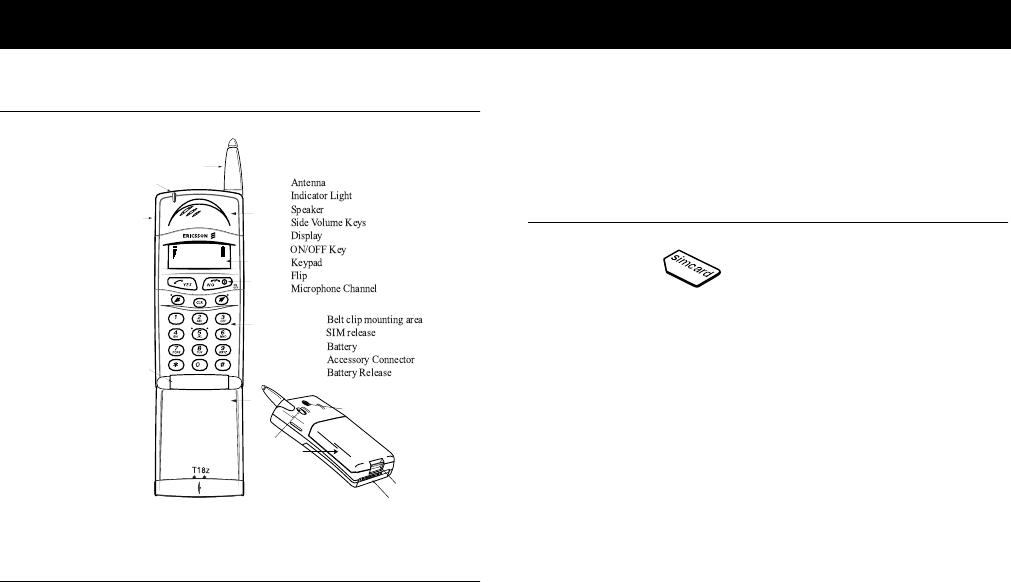
Some menus/features are operator dependent.
10 Preparing Your Phone for Use
T18z Components
Assembly
You need to do the following to use your phone:
1 Insert the SIM card
2 Attach the battery to the phone
3 Charge the battery
The SIM Card
When you register as a subscriber with a net-
work operator, you get a Subscriber Identity Module
(SIM) card. The SIM card contains a computer chip
that keeps track of your phone number, the services
included in your subscription, and your Phone Book
information.
SIM cards come in two sizes. One is the size of a credit
card, and the other is smaller. Your phone uses the
smaller card. Many credit card-sized SIM cards have a
perforated smaller card that you can take out easily.
Before you can use your phone, you must insert the SIM
card as shown below.
Preparing Your Phone for Use
➊
➋
➌
➍
➊
➋
➌
➍
➎
➎
➊
➋
➌
➍
➎
➏
➐
➑
➒
➋
➊
➍➌
➎
➒
➐
➑
➏
Network
11:33 am
+
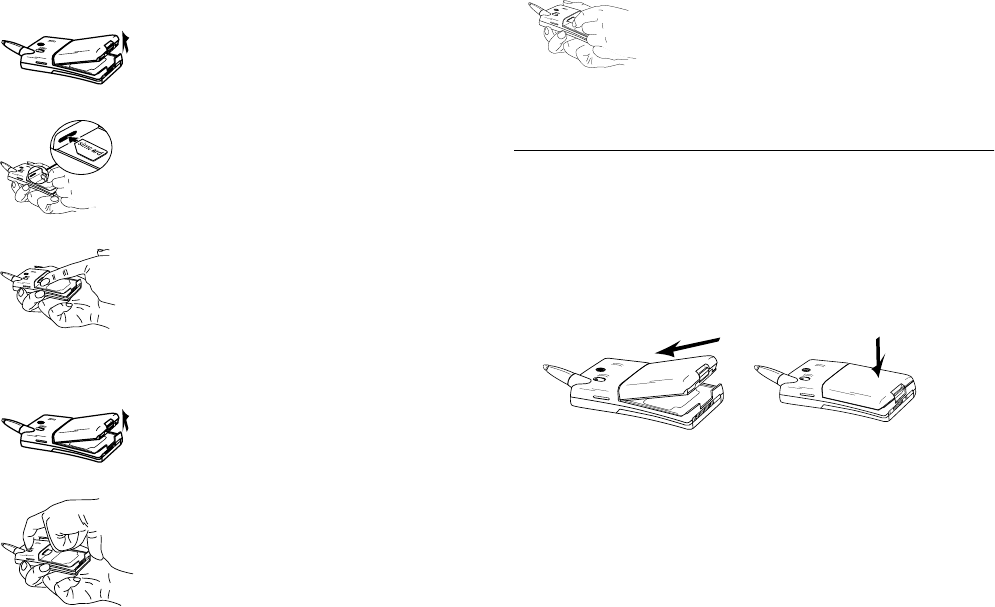
Some menus/features are operator dependent.
Preparing Your Phone for Use 11
Inserting the SIM Card
Removing the SIM Card
The Battery
Your phone comes with a nickel metal hydride (NiMH)
battery. The battery is not charged when you buy your
phone, but there may be enough power to turn the
phone on. We recommend that you charge the battery
before you use the phone for the first time.
Attaching the Battery to your Phone
Place the battery on the back of the phone and push
until you hear a click.
When to Charge the Battery
The nickel metal hydride battery that comes with your
phone can be charged whenever you wish without affect-
ing its performance. This is not the case with nickel cad-
mium type batteries, often sold as accessories by other
1 Remove the battery (if attached).
2 Slide the SIM card into the SIM card
slot with the golden connectors facing
down and the cut corner turned to the left.
3 Push the SIM card into the slot
completely.
1 Remove the battery (if attached).
2 Slide the SIM release button towards
you.
3 Pull out the SIM card.

Some menus/features are operator dependent.
12 Preparing Your Phone for Use
suppliers. For the best talk and standby time,we recom-
mend that you use only Ericsson original batteries with
your phone.
To remind you that you will soon need to charge the
battery or replace it with a charged one:
•an alarm signal (a long beep) sounds and the mes-
sage appears for two seconds in the
display. The signal is repeated several times.
•the indicator light on top of the phone starts flash-
ing red.
Note! The phone turns itself off when the battery can no
longer power it satisfactorily.
Charging the Battery
1 Make sure that the battery is attached to the phone.
2 Connect the charger to an electrical outlet.
3 Connect the other end of the cable to the phone as
shown in the picture. The flash symbol on the plug
must face upwards.
To indicate charging:
•the battery meter in the display pulses continu-
ously.
•the indicator on top of the phone shows a steady
red light (or green, if the phone is turned on).
When the battery is fully charged, the battery meter in
the display is full and the indicator on top of the phone
shows a steady green light.
Disconnecting the Charger
Disconnect the charger from the
phone by pushing the plug
upwards, and then pulling it out.
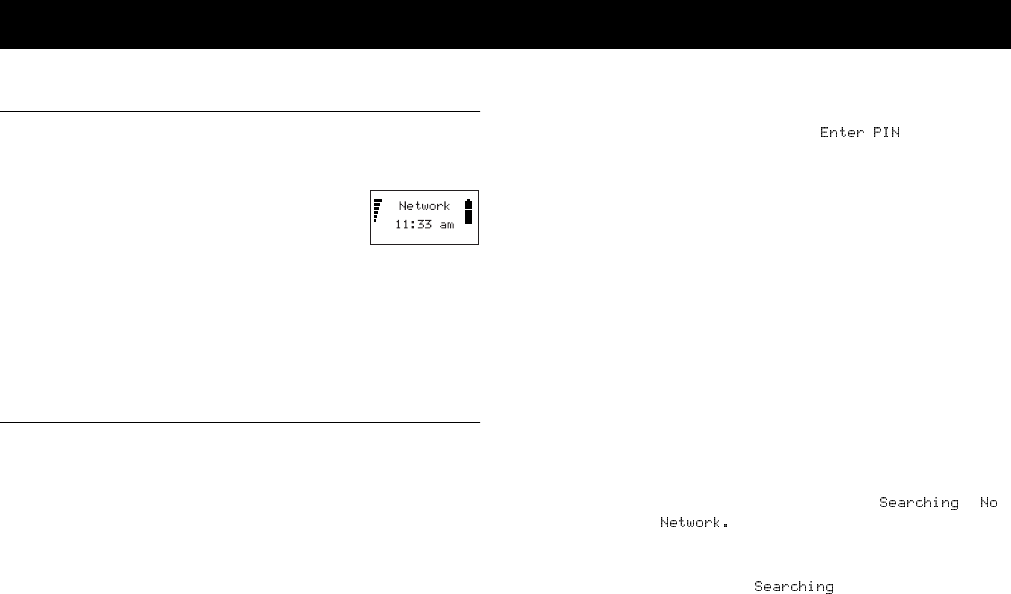
Some menus/features are operator dependent.
The Display, Keys, and Menus 13
Lotta,
Turning Your Phone On/Off
Press and hold the NO (ON/OFF) key until you hear a
beep.
When a network is found, the
phone beeps three times. The indi-
cator light on the top of the phone
flashes green once every second and
your network operator’s name appears in the display
(where “Network” appears in this illustration).
This is called standby mode. You can now make and
receive calls.
Display Messages
When “Enter PIN” appears
Some SIM cards are protected with a Personal Identifica-
tion (PIN) code. If so, you will be prompted to enter
your PIN when you turn on your phone. Also, you may
need your PIN to change settings in your phone. Fur-
thermore, some operators may have services that require
a second PIN, your PIN2.
You should be careful with your PIN, since it is your
protection against unauthorized use of your subscrip-
tion. Follow these steps if appears in the
display after you have turned on the phone:
1 Enter your PIN. If you make a mistake while entering
your PIN, erase the wrong digit by pressing the CLR
key.
2 Press
YES.
Note! If your PIN is entered incorrectly three times in a row,
the SIM card is blocked. You can unblock it by using
your Personal Unblocking Key (PUK). This code is
available from your service provider. For more informa-
tion on Locks, see “Security” on page 48 .
When “Network Search” appears
After you have turned on the phone (and entered your
PIN), the Ericsson logo, or the name of your service pro-
vider, appears in the display and the phone searches for a
network. Sometimes there is no network that you can
use. The display then shows either or
Searching
If the message remains in the display, you
are within range of a network, but you are not allowed to
use it. However, in an emergency, some operators allow
The Display, Keys, and Menus

Some menus/features are operator dependent.
14 The Display, Keys, and Menus
you to call the emergency number 911 (or 112, the
international emergency number). See “Making and
Receiving Calls” on page 18.
No network
If the message is displayed, there is no
network within range or the received signal is too weak.
You have to move to get a stronger signal.
Display Language
The first time you turn on your phone, you may want to
change the language in the display
Most SIM cards automatically set the display language
to the language of the country where you bought your
SIM card. If this is not the case, the default language is
English. You can easily reset your phone to the SIM
default if you accidentally set it to a language you do not
understand.
1 Press the
CLR key.
2 Press the key.
3 Enter
0000.
4 Press the key.
Display Icons
This illustration shows all possible icons and their place-
ment on the display. Some of the features represented in
the diagram are network dependent.
1 Signal Strength - Strength of received signal in steps.
More bars indicate more strength.
2 Alarm - The alarm clock has been set.
3 Keypad Lock - Keypad is locked.
4 Line Indicator - Tells which line is in use (if you have
alternate line service).
5 Forward- The Forward all function is activated.
6 SMS - You have received a text message.
7 Voicemail - You have received a voice message.
8 Silent Ring Signal - No sound will be heard when you
receive a call.
9 Battery - State of the battery. A fuller icon indicates
more battery strength.
1
2
36
457
9
8
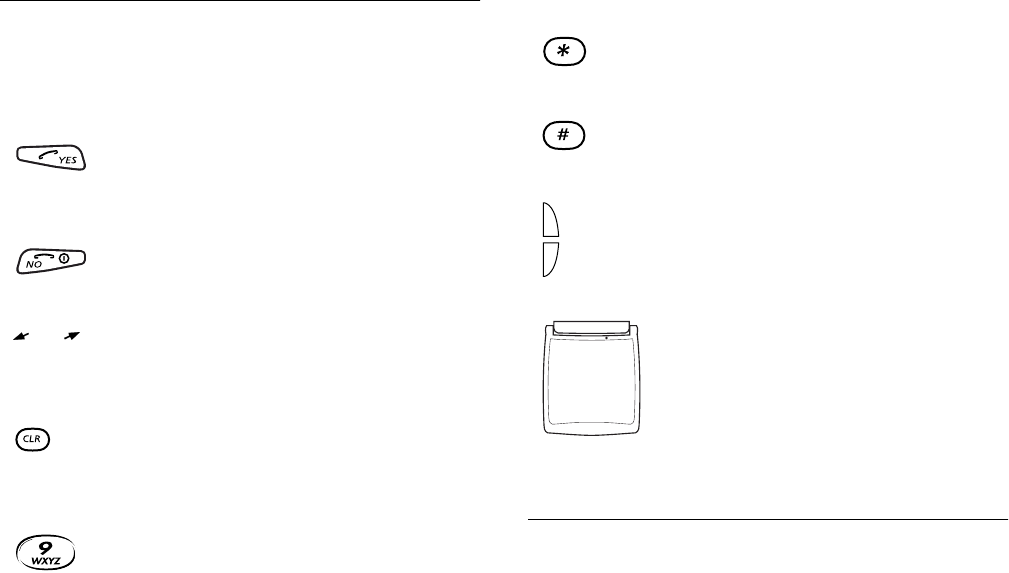
Some menus/features are operator dependent.
The Display, Keys, and Menus 15
Key Functions
The keys have multiple functions. Use this table as a
guide for getting the most of our your keypad.
Active Flip
You can answer a call by opening the flip and end it by
closing the flip. This is known as an Active Flip.
Key: Use:
•Make calls.
• Answer calls.
• Select menus or submenus.
• Initiate a voice dial call.
• Turn the phone on or off.
• End a call.
• Go back one level in a menu or leave a setting
unchanged.
and
(arrow keys)
• Access and navigate (scroll through) the menu
system.
• Erase individual digits from the display.
• Erase all digits from the display.
• Mute the microphone during a call .
• Return to standby mode.
• Mute the ringer.
• Enter the digits 0-9.
• Enters the international prefix (+) with 0 key.
• Enter special characters. For instance, to enter X,
press the 9 key twice.
• Enter a star (*) character.
• Enter a p (pause).
• Switch cases (A or a).
• Enter #.
• Terminate the input of PIN and security codes.
• Enter the phone icon.
• Increase or decrease the volume of the earpiece or
handsfree loudspeaker during a call.
• Show today’s date in the display during standby.
• Reject a call.
• Initiate a voice dial call with upper side key.
When Activated:
• Answers calls.
• Ends calls.
• Illuminates display.
Key: Use:
T18z

Some menus/features are operator dependent.
16 The Display, Keys, and Menus
Activating/Deactivating Your Flip
1 Select Active Flip from the SETTINGS menu.
2 Press
YES to activate (or deactivate) the flip.
3 will appear.
Temporarily Disabling the Active Flip
If You Do Not Want to Answer the Call
•Press and hold a side volume key while you open
the flip.
If You Do Not Want to End the Call
•Press and hold a side volume key while you close
the flip.
Navigating the Menu System
A diagram of your menu system is located on the inside
front cover of this user’s guide. You can find all your
phone’s functions in the menu system. You use the menu
system every time you want to change a setting in your
phone, such as the ring level.
The menus are arranged in a continuous loop, which
you move (Scroll) through with and . Each menu
contains a list of options. Some menus have sub-menus
with additional options. Press YES to Select a menu or
function.
Instead of pressing or repeatedly, you can press
and hold it down until you reach the menu or submenu
you want.
Note! If you enter the menu system, but do not press a key
within 60 seconds, the phone returns to standby mode.
Display Text and Symbols
When you move through the menu system, the display
changes. The following hints can help you:
•When arrows are displayed next to the name of the
sub-menu, there are more options you can scroll
through with or .
•Text in brackets shows the current setting of the
function shown in the display.
In this manual, we have chosen to exclude some of the
details in the pictures of the displays. This is so that it
will be easier for you understand the display texts.
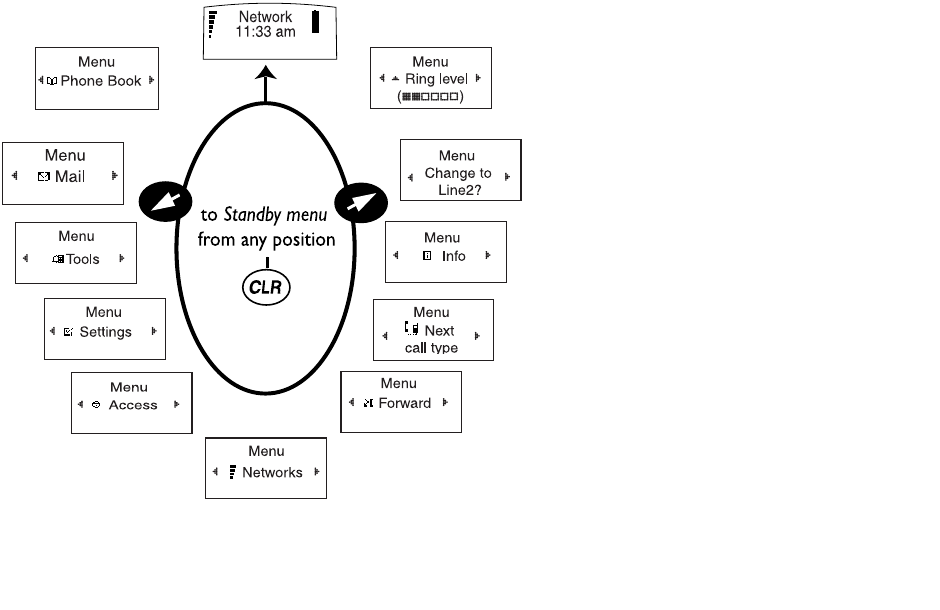
Some menus/features are operator dependent.
The Display, Keys, and Menus 17
Ring Level
Change to Line 2?
Info
Last call
Total calls
Credit
Price
Call list
Next Call Type*
Speech
Fax
Data
Forward
Phone number
Fax number*
All numbers*
Network
Select net
Searchmode
Edit list
New search
Access
Call restrict
Call waiting
Closed Calls
Card lock
Phone lock
Call Cards security
Fixed dialing
Settings
Vibrate
Ring type
Edit melody
Clock/Date
Mail alert
Keylock
Key sound
Light
Minute minder
Settings
(cont.)
Call list
Call info
Active flip
Answering mode
Handsfree
Voice answer
Voice dial
Auto store
Greeting
Phone number
Language
Data menus
LIne tag
Master reset
Tools
Set alarm
Calculator
Mail
Voicemail
Read messages
Send message
Options
Area messages
Phone Book
Name recall
Position recall
Store
Edit
Erase
Erase all from phone
Voice label lIst
Copy all
Copy
Call card numbers
Fixed numbers
Service recall
Info recall
An asterisk (*) indicates that Data Menus (within SETTINGS menu) must be activated
.

Some menus/features are operator dependent.
18 Making and Receiving Calls
In this chapter, we assume that you have turned on your
phone and that you are within range of a network. If you
are away from home, you may use other networks, pro-
vided your home network has an agreement that allows
you to do this (see also “Networks” on page 58).
Making a Call
1 Enter the phone number (the area code may be neces-
sary).
2 Press
YES.
The display will show and then
. Once connected, a time counter automatically
starts and you can see how long you have been on the
phone. A phone icon will appear in the display.
If you have activated the Call Cost option (see “Call
Time and Call Cost” on page 65 “) and your network
and SIM card supports it, you also see the price of the
call in the display.
Ciphering
Ciphering is a built-in feature that “scrambles” your calls
and messages to provide additional privacy. An exclama-
tion point next to the phone icon during a call indicates
that ciphering is currently not available from the service
provider.
Redialing a Previously Called Number
1 Press YES.
2 Press or until the number (and name) you want
to all appears.
3 Press
YES to make the call.
Automatic Redialing
If the display shows you can redial the number
by pressing YES. When the call is answered, you hear a
beep followed by a ring signal.
Your phone automatically redials (up to 10 times) until:
•the call is answered.
•you press a key or receive a call.
Making and Receiving Calls
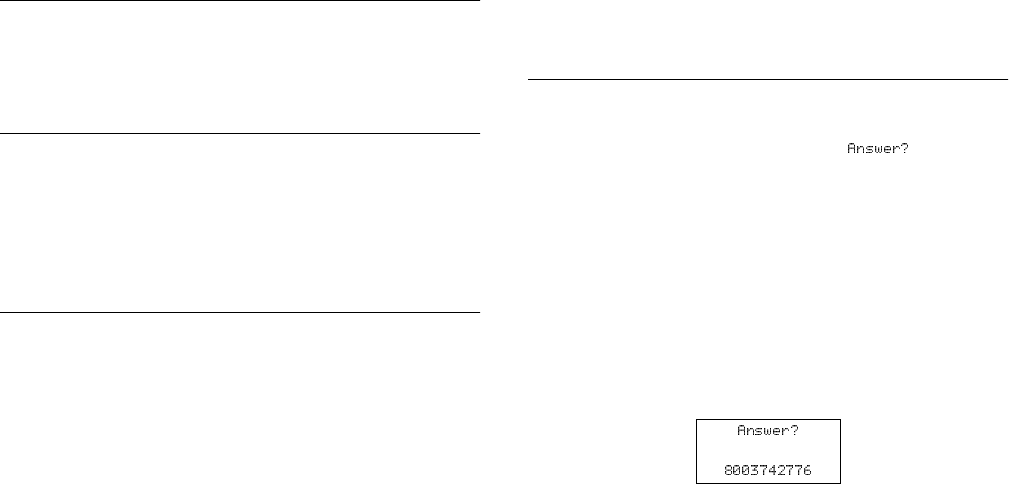
Some menus/features are operator dependent.
Making and Receiving Calls 19
Ending a Call
•Close the flip (if activated) or
•Press NO to end the call.
Making International Calls
1 Press and hold the 0 key until a + sign appears.
2 Enter the country code, area code (without any lead-
ing zero) and phone number.
3 Press
YES.
Making Emergency Calls
1 Enter 911 (or 112, the international emergency num-
ber).
2 Press
YES.
Note! The emergency number 911 (or the international emer-
gency number, 112) can be used in most countries, with
or without a SIM card inserted, if a GSM network is
within range. Some network operators may require that
a SIM card is inserted, and in some cases that the PIN
code has been entered, as well. Check with your service
provider.
Some networks may not use the emergency number,
911. The international emergency number is 112. If
you are unsure of what emergency number is used in
your country, please contact your network operator or
service provider.
Receiving Calls
When a call is received, the phone rings and the indica-
tor light on the top of the phone flashes green rapidly.
The display flashes and shows
Note! If the Backlight setting is On, backlight will stay on. If it
is set to Off/Auto, it will flash when a call is received.
Note! The phone has a built-in vibrating unit which allows
you to receive calls discretely. See “Vibrating Unit” on
page 32 .
If your subscription includes the Call Line Identifica-
tion (CLI) service and the caller’s network sends the
number, you see the caller’s number in the display. If the
caller’s number and name is stored in the Phone Book,
the caller’s name is displayed too.
Answering a Call
•Open the flip (if activated)
•Press YES, if the flip is open.

Some menus/features are operator dependent.
20 Making and Receiving Calls
•Voice Activated Answer (Refer to “Answering or
Rejecting a Call Using Voice Activation” on
page 64.)
Rejecting a Call
You can reject a call by any one of the following meth-
ods:
•Double-click one of the volume keys on the side of
the phone.
•Press NO, if the flip is open.
•Close flip (if activated and open).
•Voice Activated Answer (Refer to “Answering or
Rejecting a Call Using Voice Activation” on
page 64.)
The caller hears a busy tone if the function is supported
by the caller’s network. If Forward on Busy is activated,
the call is forwarded to the number you have specified.
During a Call
Your phone has several functions which you might find
helpful while a call is in progress.
Changing the Earpiece Volume
•Pressing the upper side volume keys increases the
volume.
•Pressing the lower side volume keys decreases the
volume.
Muting the Microphone
Note! All digits must be removed from the display before mut-
ing can be used.
1 Press and hold the CLR key.
appears in the display.
2 To continue your conversation, release the CLR key.
Note! Instead of pressing and holding the CLR key, you can
put the call on hold.
Putting the Call on Hold
Press YES. 1 appears in the display
1 To continue your conversation, press YES again.
Scratch Pad Function
If you need to make note of a phone number during a
call, you can use the Scratch Pad.
1 Use the number keys to enter the number.
Some menus/features are operator dependent.
Making and Receiving Calls 21
2 When you end the call, the number remains in the dis-
play. You can now call the number by pressing YES, or
save it in the Phone Book (see “Your Phone Book” on
page 22).
Sending Tone Signals
To use telephone banking services or to control an
answering machine, you need to use codes. These codes
are sent as tone signals (also known as DTMF tones or
touch tones).
Press the appropriate keys (0-9, * and #).
Note! You can also save a code together with a phone number
in the Phone Book. See “Your Phone Book” on page 22.
Checking Duration/Cost of Call
During a call, the display shows the duration in minutes
and seconds. If you prefer, you can have the call cost dis-
played, provided your network and your SIM card sup-
port this feature. See “Call Time and Call Cost” on
page 65 on how to use this feature.
Handling Simultaneous Calls
Your phone is capable of handling more than one call
simultaneously. You can put the current call on hold,
and then make or answer a second call. You can also set
up a conference call with up to five other people. See
“Call Waiting Service” on page 54 and “Conference
Calls” on page 56 on how to use this feature.

Some menus/features are operator dependent.
22 Your Phone Book
You can create a personal phone book by storing phone
numbers and accompanying names on the SIM card
(card memory) and in the phone (phone memory). You
use the PHONE BOOK menu for storing and recalling
all the phone numbers in your phone book.
Every phone number you store includes a position num-
ber, shown in brackets.
You can store the phone numbers together with a name
tag to make it easier for you to keep track of your phone
numbers. If the position number has a phone icon next
to it, this means that you are storing the phone number
in the phone memory and cannot take it with you if you
change phones. The phone memory can hold up to 100
phone numbers. The number of memory locations on
your SIM is dependent on your network subscription.
Unless otherwise specified, phone book entries will be
stored on your SIM. Once the SIM is full, the entries
will be stored in the phone’s memory.
Entering Characters
You can only enter letters when you are using the phone
book and when you are composing a short message
(SMS), see “Short Message Service” on page 37”.
Press the appropriate key, 1–9, 0 or #, repeatedly until
the character you want appears in the display.
Example: to enter an , press 2 once. To enter a , press
2 twice.
Your Phone Book
Press… to get…
1Space - ? ! ‚ . : ; " ’ < = > ( ) 1
2 A B C Å Ä Æ à Ç 2 Γ
3D E F è É 3 ∆ Φ
4 G H I Ì 4
5J K L 5 Λ
6 M N O Ñ Ö Ø ò 6
7P Q R S ß 7
Π Σ
8T U V Ü ù 8
9 W X Y Z 9
0 + & @ / ¤ % $ £ ¥ § ¿ ¡ 0 Θ Ξ Ψ Ω
## *

Some menus/features are operator dependent.
Your Phone Book 23
Quick Tips
Entering Lowercase Letters
Enter the letter, for example an , and then press *. An
appears. Lowercase letters now appear until you press *
again.
Entering Digits
When entering special characters, you can go directly to
the keypad number by pressing and holding the number
key.
Inserting the Phone Book Icon
In the PHONE BOOK menu, press # to enter the
phone icon. Outside the PHONE BOOK menu, you
must press and hold # to enter it.
Storing a Number Together with a Name
1 Enter the area code and phone number you wish to
store.
2 Scroll to PHONE BOOK and press YES.
3 Select Store.
The first free memory position is suggested.
4 Enter the name tag that you want to associate with the
number.
5 Press
YES. appears.
6 If you do not want to record a voice label, press NO.
Press YES to record.
7 Say the voice label after the tone. The voice label is
played back to you.
8 If you are satisfied, press YES to store the voice label.
Otherwise, press NO and follow the prompts.
Once stored in your phone book, the voice label icon
appears next to the position number.
For more information on voice recognition, see “Voice
Activation” on page 61.
Note! If you intend to use your phone away from your local
area, you should store all phone numbers with the area
code. If you intend to use your phone internationally,
you should also include the international prefix (+). The
international prefix will automatically be replaced by the
international dialing prefix for the country you are call-
ing from, followed by the country code, the area code,
and the phone number.
Storing in a Different Position than Suggested
After you have entered a phone number to be stored and
selected the Store function, you can choose what posi-
tion to store the number in.

Some menus/features are operator dependent.
24 Your Phone Book
Saving in a position of your choice in the
card memory:
Press and enter a position number of your choice.
Saving in a position of your choice in the
phone memory:
Press and press # once. Enter the position followed by
YES.
Saving in the first empty position in the
phone memory:
Press and press # twice followed by YES.
Overwrite Protection
If you try to store a phone number in a position which
already contains a phone number, the message
appears in the display.
Then do one of the following:
Storing in the selected position
Press YES to replace the number with the new one.
Storing in a different position
1 Press NO.
2 Enter the new position number.
3 Press
YES.
When a Memory is Full
If you try to store a phone number and the memory you
want to store it in is full, the phone suggests a position
number in the memory that is not full.
When Both Memories are Full
If both memories are full, the phone does not suggest a
storage position. If you still want to store the number,
you have to erase an old number by entering a position
that is already occupied and press YES.
Erasing a Storage Position from the SIM Memory
1 Scroll to PHONE BOOK and press YES.
2 Scroll to . Press YES.
3 Enter, or scroll to, the position number you want to
erase.
4 Press
YES.
Erasing a Storage Position from the Phone Memory
1 Scroll to PHONE BOOK and press YES.
2 Scroll to and press YES.
3 Press #. The phone icon appears.
4 Enter, or scroll to, the position number you want to
erase.
5 Press
YES.
Note! If you choose , all phone
numbers that are stored with the phone icon are lost.

Some menus/features are operator dependent.
Your Phone Book 25
Using the Phone Book
There are two ways of using the phone book: you can
either call a number by using the name tag stored with
it; or you can call the number by using the memory
position that the number is stored in.
Calling Using the Name
1 Clear the display.
2 Scroll to PHONE BOOK and press YES.
3 Select Name recall.
4 Enter the name of the person you want to call, or
scroll with until you find it.
5 Press
YES to call the number.
Calling Using the Position
1 Clear the display.
2 Scroll to PHONE BOOK and press YES.
3 Select Position recall.
4 Enter the position number you want to call and press
YES.
If You Know the Position Number
1 Enter the position number.
2 Press #.
3 The name will appear.
4 Press
YES to call.
Speed Dialing (memory positions 1 - 9)
1 Clear the display.
2 Press a position number, 1 - 9.
3 Press
YES.
Keeping the Phone Book Up to Date
Sometimes people change their names, their phone
number, or even both. To get the best use out of your
phone book, you want the names and numbers to be
correct. They are easily changed with the Edit Phone
Book feature. If someone has changed both name and
number, it might be easier to overwrite the old storage
position with the new one, instead of changing both
name and number separately.
Changing a Phone Number in Your Phone Book
1 Clear the display.
2 Scroll to PHONE BOOK and press YES.
3 Select Edit.
4 Scroll to Find name.
5 Enter the full name and press YES.
6 Press once to move the cursor to the row with the
phone number.
7 Move the cursor with to where you want to
change the number.
8 Enter the new number or clear the display with CLR.

Some menus/features are operator dependent.
26 Your Phone Book
9 Press
YES.
Changing a Name in Your Phone Book
1 Clear the display.
2 Scroll to PHONE BOOK and press YES.
3 Select Edit.
4 Scroll to Find name.
5 Enter the name and press YES.
6 Use to navigate.
7 Change the name by entering or erasing letters.
8 Press
YES.
Entering the Phone Book Alphabetically
You can access entries in your phone book using the key-
pad. For example, to access entries beginning with A-C,
press the 2 key. To access entries beginning with M-O,
press the 6 key.
Copying Phone Numbers Between Memories
If you want to use a different SIM card or phone, it is a
good idea to copy your phone book from the SIM card
to the phone memory or vice versa. Then you can easily
copy the phone book back to the memory of your
choice. Also, as you fill up the phone book memories,
you might want to move entries from one memory to
another.
Copying a Number from SIM Memory to Phone Memory
1 Scroll to PHONE BOOK and press YES.
2 Select Copy.
3 Select Card Phone.
4 Enter the number of the first memory position in the
SIM memory you want to copy to the phone memory
and press YES.
5 Enter the number of the first memory position in the
phone memory you want to copy to and press YES.
6 Press
YES to copy.
The next position in the SIM memory is displayed and
the first empty position in the phone memory is sug-
gested.
7 To continue copying, press one of the following:
•YES to copy.
•NO to go to the next position in the SIM memory.
•CLR to copy to another position in the phone
memory. Enter the number of the position and
press YES.
• and to move between positions in the SIM
memory.
Interrupting Copying
•Press CLR twice.
Copying a Number from Phone Memory to SIM Memory
Follow the instructions in “Copying a Number from
SIM Memory to Phone Memory”, but chose the Phone

Some menus/features are operator dependent.
Your Phone Book 27
Card option in the PHONE BOOK menu instead of
Card Phone.
Copying All Numbers from SIM to Phone Memory
1 Scroll to PHONE BOOK and press YES.
2 Select Copy all.
3 Select Card Phone.
4 Enter the number of the first position in the SIM
memory you wish to copy to the phone memory and
press YES.
5 Enter the number of the first position in the phone
memory you wish to copy to and press YES.
6 Press
YES to start copying.
Copying All Numbers from Phone Memory to SIM
Follow the instructions in “Copying a Number from
SIM Memory to Phone Memory”, but choose the
Phone Card option in the PHONE BOOK menu
instead of Card Phone.
Using the Call List
This chapter describes the Call List function, which is a
type of telephone number log or a memory that stores
information (time, date, phone number, and name - if
stored in phone book) about the last 30 incoming and
outgoing calls. Once your list exceeds 30 calls, the oldest
one is deleted.
The numbers that you have dialed are always stored. If
your subscription includes the CLI service and the
caller’s network sends the number, you will find the
number (together with a name if stored in your phone
book) of an incoming call in the Call List. You can call
any of the stored numbers. The following icons appear
in the display together with the name and number.
All the calls are stored together in chronological order. If
the same number is called more than once, the latest call
replaces earlier ones. If you check a call made on the
same day, the time of the call is displayed. Otherwise,
the time is replaced by the date. You can toggle between
date and time by pressing *.
If no information about the caller’s number was
received, the display shows , which means
that no information was available, your subscription
does not support CLI, or the caller did not allow the
number to be shown.
Icon Explanation
The Answered calls icon appears next to the date or
time of answered calls.
The Missed calls icon appears next to the date or
time of missed calls.
The Dialed numbers icon appears next to the date or
time of a dialed number.

Some menus/features are operator dependent.
28 Your Phone Book
Note! If you change SIM cards or deactivate the Call List, it is
cleared. Dialed numbers remain in the SIM card mem-
ory.
Activating the Call List Function
1 Scroll to SETTINGS and press YES.
2 Select Call list, On.
Calling a Number from the Call List
Press YES from Standby.
or
1 Scroll to INFO and press YES.
2 Select Call list.
3 Scroll to the number that you want to call.
4 Press
YES to make the call.
Missed Calls
If you have missed a call, the phone shows ,
where the number 1 indicates the number of unan-
swered/missed calls.
Press YES to go directly to the call list.
Erasing a Number from the Call List
1 When the caller’s name, number, and time of call
appears, press CLR. appears.
2 Press
YES.
Turning the Call List Memory Off
1 Scroll to SETTINGS and press YES.
2 Select Call list, Off.
Note! If you turn the Call list off, all stored entries are erased.
Calling Line Identification (CLI)
If your subscription includes the CLI service and the
caller’s network sends the number, you see the caller’s
number at the bottom of the display when you receive a
call. If the number is stored with a name in the phone
book, the name is also shown in the display.
Hiding or Showing Your Phone Number
With most subscriptions, the receiver can see your
phone number when you make a call. However, some
operators offer subscriptions where your phone number
is normally hidden. If you want to change the setting for
a particular call, this is possible, provided the network
you use supports it.
Hiding Your Phone Number for a
Particular Call
1 Enter the phone number you wish to call.

Some menus/features are operator dependent.
Your Phone Book 29
2 Scroll to SPECIAL FUNCTIONS and press YES.
3 Select Hide ID.
Showing Your Phone Number for a Par-
ticular Call
1 Enter the phone number you wish to call.
2 Scroll to SPECIAL FUNCTIONS and press YES.
3 Select Send ID.

Some menus/features are operator dependent.
30 Personalizing Your Phone
Your phone includes a number of functions which let
you adapt your phone to your own personal needs in dif-
ferent situations. Note that some of the functions allow
you to have one setting when the phone is handheld and
another when it is connected to handsfree equipment.
See “Calling from Your Car” on page 69“.
Ring Signal Volume
You have eight ring level choices. You can choose from
six ring levels, turn the ring signal off (0), or select a ring
signal that rises in steps from the softest volume to the
loudest.
To set the ring signal volume
1 Scroll to RING LEVEL and press YES.
The ring signal volume appears in the display.
2 Use increase the volume, to decrease it.
The phone rings once with the actual setting as you
increase the volume, except for the Step (^)setting.
3 Press
YES to save the setting.
Note! Use the volume keys on the side of the phone to change
the volume of the ring signal silently.
Ring Signal Type
You can choose the type of ring signal from a list of dif-
ferent ring tones and melodies. You can also compose up
to four melodies of your own by entering notes with the
keypad (see “Your Own Ring Signals” on page 32 ).
Ring Tones
1 Low
2 Medium
3 High
4 Mix
Note! When the lowest setting is selected, the phone will only
click twice. If the Vibrating Unit is also activated, the
phone will click twice and the unit will vibrate continu-
ously.
Melodies
1 Scotland the Brave
2 Bronzol
3 Toccata
Personalizing Your Phone

Some menus/features are operator dependent.
Personalizing Your Phone 31
4 Sailors Hornpipe
5 The Entertainer
6 Eine Kleine Nachtmusik
7 Für Elise
8 Bergakungens Sal
9 Vivaldi - Four Season - Spring
10 Boccherini - Menuett
11 Verdi - Rigoletto
12 Grieg - Per Gynt
13 Brahms - Hungarian dance number 5
14 Trad. - Gärdebylåten
15 Wagner - Valkyrian
To choose one of the ring signal types
1 Scroll to SETTINGS and press YES.
2 Select Ring type.
3 Select Phone.
4 Scroll until you find the ring signal type that you
want.
If you do not wish to disturb other people, use the vol-
ume keys on the side of the phone to scroll silently.
5 When you reach the ring type you want, select it by
pressing YES.
Different Ring Signals for Line 1 and Line 2
If you subscribe to the Alternate Line Service (ALS), L1
or L2, depending on the line in use, is displayed instead
of Phone. This means that you can set different ring sig-
nals for the two lines.
Different Ring Signals for Speech, Data and Fax Calls
If you have turned the DATA menus on (see “Sending
and Receiving Faxes and Data” on page 70), you can set
different ring signals for speech, L1 or L2, fax, and data
calls.
Personal Ring Signals
If your subscription includes the CLI service, you can
assign a personal ring signal for up to 10 callers. In other
words, you can have one ring signal that corresponds to
your home phone number, one to your office, etc.
If the last seven digits of a caller’s number correspond to
a number you have specified, then that caller’s ring signal
is used.
You can include question marks (?) in a phone number.
For example, 919555???? means that calls from phone
numbers between 9195550000 and 9195559999 will
have the same personal ring signal. To enter a ?, press #.
Specifying a Caller’s Number and the
Accompanying Ring Signal
1 Scroll to SETTINGS and press YES.
2 Select Ring type.
3 Select Personal.
4 appears.
5 Press
YES.

Some menus/features are operator dependent.
32 Personalizing Your Phone
6 Enter the caller’s number and then press YES.
If a phone number is stored in the phone book, press
to recall the number.
7 Scroll to ring signal type you want and then press YES.
Erasing a Caller’s Number
1 Scroll to SETTINGS and press YES.
2 Select Ring type.
3 Select Personal.
4 Scroll to .
5 Press
YES.
6 Scroll to the number you wish to erase and then press
YES.
Your Own Ring Signals
You can compose four ring signals.
Composing a Ring Signal
1 Scroll to SETTINGS and press YES.
2 Select Edit melody.
3 Select Own 1, Own 2, Own 3, or
Own 4.
4 Press and hold CLR to clear the
display.
5 Use the keypad to enter notes.
The keypad now works as a key-
board.
6 Press and hold a key to enter a
long note.
7 Press
0 to raise the note one octave.
8 To listen to your melody, press YES.
9 Press
YES again to save it or press NO to continue edit-
ing.
Vibrating Unit
You can set the phone´s vibrating unit to Off, On, or
On when silent when the ring signal is turned off.
1 Scroll to SETTINGS and press YES.
2 Select Vibrate.
3 Select the desired setting.
Minute Minder
If you turn on the minute minder, you hear a beep once
every minute during a call.

Some menus/features are operator dependent.
Personalizing Your Phone 33
1 Scroll to SETTINGS and press YES.
2 Select Minute minder.
3 Select On or Off.
Message Signal
You can choose whether to hear clicks, tones or nothing
(silent) when you receive a text (SMS) or voice message.
1 Scroll to SETTINGS and press YES.
2 Select Mail alert.
3 Select the sound you wish to hear.
Key Sound
You can choose whether to hear clicks, tones, or nothing
(silent) when you press the keys.
1 Scroll to SETTINGS and press YES.
2 Select Key sound.
3 Select the key sound you want.
Note! The side volume keys and flip will also click when the
key sound is set to click. With all other settings they are
silent.
Display Light
You can set the display light to automatic, off or on. In
automatic mode, the display light is turned off automat-
ically 10 seconds after you pressed the last key. It comes
on again when you press a key, open the flip, or when
you receive a call or message
1 Scroll to SETTINGS and press YES.
2 Select Light.
3 Select the display light setting you want.
Display Language
The default language on your SIM card is English.
To change the display language:
1 Scroll to SETTINGS and press YES.
2 Select Language.
3 Select the language you want.
Note! If by accident you end up with your phone displaying a
language you do not understand, you can return to the
SIM default by pressing CLR , 0000 .
Greeting Text
This feature is network dependent.

Some menus/features are operator dependent.
34 Personalizing Your Phone
When you turn on your phone, your service provider’s
name or the Ericsson logotype appears in the display.
Instead of this, you can write your own greeting.
1 Scroll to SETTINGS and press YES.
2 Select Greeting.
3 Select New text.
4 Write your new greeting, using the number keys. For
information on how to enter letters, see “Your Phone
Book” on page 22.
5 Press
YES to confirm your setting.
Turning the Greeting ON/OFF
1 Scroll to SETTINGS and press YES.
2 Select Greeting.
3 Select On or Off.
Reverting to the Ericsson Logotype
1 Scroll to SETTINGS and press YES.
2 Select Greeting.
3 Select New text.
4 Press and hold CLR to erase the greeting text. Then
press YES.
Phone Number Display
You can have your phone number displayed when you
turn the phone on. This requires that you have replaced
the Ericsson greeting with a greeting text of your own, or
turned the Ericsson greeting off. If your phone number
cannot be retrieved from your SIM card, you have to
enter it yourself.
Entering your Phone Number
1 Scroll to SETTINGS and press YES.
2 Select Phone no.
3 Select Phone no. (again).
4 Enter the number and then press YES.
Note! If your SIM card allows it, you can also enter your fax
and/or data number.
1Scroll to SETTINGS and press YES.
2 Select Phone no.
3 Scroll to Fax no. or Data no. and press YES.
4 Enter the number and then press YES.
Time
The time is always displayed when the phone is in
standby mode.
Setting the Time Format
1 Scroll to Settings and press YES.
2 Select Clock/Date.
3 Select Set clock.

Some menus/features are operator dependent.
Personalizing Your Phone 35
4 Select the 24-hour or 12-hour (am/pm) clock. Twelve-
hour is the default.
Setting the Clock
1 Enter the time in hours and minutes.
If you selected the 12-hour clock, you can alternate
between am and pm by pressing # or *.
2 Press
YES.
Date
When the phone is in standby mode, you can press a
volume key to the current date. Use the lower side vol-
ume key if voice activation is active. The default date
format is mm-dd-yy.
Setting the Date Format
1 Scroll to SETTINGS and press YES.
2 Select Clock/Date.
3 Select Set date.
4 Select the date format you want.
5 Enter the year (two digits) and then press YES.
6 Enter the month and day in the same way.
Auto Store
You can choose to let the phone prompt you to store a
called number that is not stored in your phone book.
The phone then asks when the call has ended.
Turning the Function ON/OFF
1 Scroll to Settings and press YES.
2 Select Auto store.
3 Select On or Off.
Master Reset
You can reset some settings to their default values. If you
do so, the following settings are affected:
•all settings in the SETTINGS menu, except your
own ring signal melodies,
•the ring signal volume
•the earpiece volume and the handsfree speaker vol-
ume,
•the alarm function in the TOOLS menu is turned
off, and
•the Area info and Reply Request in the MAIL
menu are turned off.
Resetting the Phone to Default
Enter 73738 or

Some menus/features are operator dependent.
36 Personalizing Your Phone
1 Scroll to SETTINGS and press YES.
2 Select Master reset.
3 Enter the phone lock code (the default code is 0000)
and press YES.
Resetting the Display Language to SIM
Default
Enter 0000 .

Some menus/features are operator dependent.
Mail Services 37
Your phone is equipped with two types of mail: Short
Message Service (SMS) and Voice m a il.
SMS, or text messaging, allows you to send and receive
text messages consisting of up to 160 characters.
Voicemail is a service that allows callers to leave voice
messages when you cannot answer your calls. This chap-
ter will provide instructions on using the SMS and
Voicemail services.
Short Message Service
You can receive text messages when the phone is in
standby mode, during a call or when incoming calls are
forwarded to another phone number. If your phone is
turned off when a message is sent to you
will appear shortly after you turn your
phone on.
If your SIM card does not contain the phone number to
your network service center, you must specify the num-
ber yourself. Otherwise you cannot reply to messages
received or send your own messages. See “Enabling the
Phone to Send SMS” on page 37 .
Note! The Short Message Service may not be available on all
networks. Some network operators may only allow SMS
to be sent within their own network.
Enabling the Phone to Send SMS
If you want to send or reply to a message, you need to
make sure that the service center number is set. Most
modern SIM cards already contain this information at
the time of purchase. You can obtain the service center
number from your network operator.
Setting the Service Center Address
1 Scroll to MAIL and press YES.
2 Select Options.
3 Select Serv Center.
4 If no number appears in the display, enter the number
of the service center, including the international prefix,
and press YES.
5 Press
CLR to return to standby mode.
Your phone is now ready to send text messages.
Enhancing Your Text Messages
Before you send your message, you can set the type of
message, the duration of repetitions, and if you want to
have a reply to your messages.
Mail Services

Some menus/features are operator dependent.
38 Mail Services
Message type
Your phone can send other types of messages. Your net-
work operator’s service center may offer the facility to
convert a text message into a format (e-mail, fax, telex,
etc.) that suits the equipment that is going to receive the
message. Check with your network operator to find out
which message types you can use and how.
To change message types
1 Scroll to MAIL and press YES.
2 Select Options.
3 Select Msg type.
4 Scroll to the format that you want and press YES.
Repetition of Message
If your message cannot be delivered because the receiver
is not within reach of a network, you can instruct your
Service Center to repeat the message for a certain length
of time.
Setting Repetition of a Message
1 Scroll to MAIL and YES.
2 Select Options.
3 Select Valid period
4 Scroll to the time span that you want and press YES.
Reply to Messages
Sometimes you may want the receiver of your message to
reply. If so, you need to set the request reply prompt.
Setting the Request Reply Prompt
1 Scroll to MAIL and press YES.
2 Select Options.
3 Select Reply req.
4 Select On or Off.
Composing a Text Message
For more information on how to enter text, see “Your
Phone Book” on page 22.
Editing the Written Text
1 Scroll through the message text with the arrow keys
and erase characters to the left of the cursor using CLR,
or insert characters to the right of the cursor.
2 Press
1 to insert a space.
Note! To scroll to the beginning of the message, press until
you reach the characters you want to view.
Note! If there is a pause of more than 120 seconds between
entering characters, the phone stores the message and
returns to the standby menu.
Sending a New Text Message
1 Scroll to MAIL and press YES.
2 Select Send message.
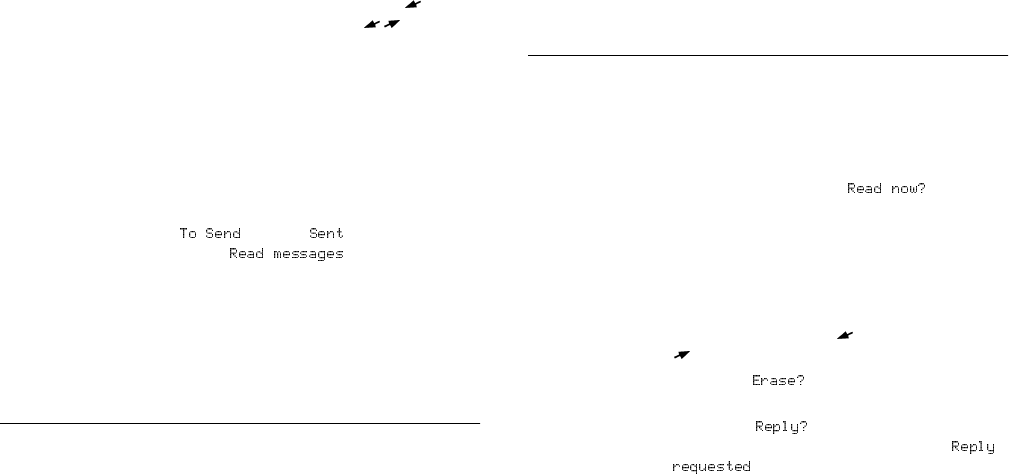
Some menus/features are operator dependent.
Mail Services 39
3 Select New.
An empty display appears.
4 Enter your message.
5 When you have completed your message, press YES.
6 Enter the receiver’s phone number or recall it from the
phone book.
Note! To a c c e s s t h e PHONE BOOK menu, press twice.
Scroll through the phone book using .
Send Now or Later?
When you have entered or recalled the receiver’s num-
ber, you have two options:
•To send the message now, press YES.
•To store the message for later use, press NO. The
message is now stored in the message memory.
If you decide to send the message later, the message is
labeled instead of when you access the
message in the menu.
Note! The same procedure is used with all types of messages,
such as e-mail or fax. Check with your network operator
to find out which message types you can use. You have
to change the message type first.
Sending a Stored Message
1 Scroll to MAIL and press YES.
2 Select Send message.
3 Scroll to the stored message you wish to send and press
YES.
4 Now you can edit your message. When you are ready
to send the message, press YES.
5 Re-enter the phone number.
6 To send the message press YES.
Receiving a Message
When you receive a message, you hear a sound and the
display indicates that you have a new message. The indi-
cator light on the top of the phone rapidly flashes green.
Read the Message Now
1 Press YES when you see the prompt.
The display shows the status of the message (New) and
when it was received. If your network supports CLI,
the sender’s number is also displayed. If the sender’s
number and name is stored in the phone book, his or
her name is shown instead.
2 Press
YES to read the message. Scroll through the mes-
sage using the arrow keys ( takes you forwards and
takes you backwards through the message).
3 The prompt appears after the last line of the
message. Press YES to erase.
4 Press
NO and will appear. If the sender wants
you to reply, the displayed message will read
provided that your network supports
this. See “Replying to a Message” on page 41.

Some menus/features are operator dependent.
40 Mail Services
Reading the Message Later
•Press no when you see the prompt.
The message is stored in the message memory as
New and the envelope icon appears at the bottom
of the standby display.
Reading a Stored Message
1 Scroll to MAIL and press YES.
2 Select Read messages.
3 Scroll to the message you are looking for.
New means an unread message.
Old means a read message.
Sent means a message that you have sent yourself.
To S e n d means a message you have written, but not
sent.
4 Press
YES.
5 Read the message as described in “Receiving a Mes-
sage”.
Note! To go to the next line in the message, press .
Note! If there is an icon in the shape of a SIM card in front
of the message, it means that it is stored on the SIM
card.
Note! When viewing the top line of the message, press * to
switch between seeing the time and date the message was
received.
Embedded Numbers
Sending an Embedded Number
When sending a message to another wireless phone, or
when asking someone to send a message to your Ericsson
phone, you should follow the guidelines listed below to
ensure that the phone retrieves the entire number from
the message, displays it, and allows the phone user to
dial the number by pressing YES.
A phone number enclosed within double quotation
marks has the highest probability of being recognized
(e.g. “9195551212”).
Other ways to write the phone number within messages
are:
•9195551212
•919-555-1212
•+19195551212
Note! If you are sending an embedded number internationally,
it is best to include the international dialing code, area
code, and area prefix as part of the number to help in the
call back process. The receiver of the message has the
option of editing a number before attempting to call
back.
Note! If the number embedded in the SMS matches a phone
book entry, a name will be displayed when the embed-
ded number is dialed.

Some menus/features are operator dependent.
Mail Services 41
Calling an Embedded Number
•Press YES to call the embedded name/number. If
there are multiple numbers in the display, the first
number will be dialed.
Replying to a Message
1 Scroll to the end of the message.
The prompt appears.
2 Press
YES to reply (press NO if you do not want to
reply).
3 Press
YES and proceed as described in “Composing a
Tex t Me s s a ge ” .
Erasing a Message
1 Scroll to the end of the message.
The prompt appears.
2 Press
YES to erase. The next message automatically
appears in the message list.
Note! Press and hold CLR within a message to clear.
Storing Incoming Messages
If you do not want to read an incoming message at once,
it is automatically stored in the message memory in the
phone. This allows you to read it later. If there are any
unread messages in the message memory, the envelope
icon appears at the bottom of the standby display. The
message is stored in the message memory as New.
The message memory can hold up to 15 messages.
When all memory positions are full, the oldest read mes-
sage is overwritten when a new unread message is
received.
If the message memory becomes full with unread mes-
sages, new messages are automatically stored in the SIM
card memory. If the SIM card memory becomes full, the
envelope icon starts flashing.
Messages remain in the message memory until you erase
them (see “Erasing a Message” on page 41), until you
insert a different SIM card, or until the telephone needs
the memory space to store new messages.
The SIM Card Memory
You can store important messages in a memory on your
SIM card. This means that you can find them no matter
which phone you use. Messages that are saved in the
SIM card memory remain there until you erase them.
The maximum number that you can store depends on
your SIM card.

Some menus/features are operator dependent.
42 Mail Services
If the SIM card memory becomes full, the envelope icon
starts flashing. The text
appears. You will have to erase one or more messages,
before you can store any new messages in the SIM card
memory.
Storing a received message in the SIM
card memory
1 Press NO.
The prompt appears.
2 Scroll to the end of the message.
The prompt appears.
3 Press
NO.
The prompt appears.
4 Press
YES. The message automatically moves from the
message memory to the SIM card memory. The dis-
play now shows the position of the message. For exam-
ple, if it is the third of 15 that the phone can store.
Note! You can also store messages you have composed yourself
on the SIM card. See “Own Messages” on page 42.
Own Messages
You can store up to 10 standard messages, to be reused
whenever you want. The messages must not exceed 30
characters.
Creating an Own Message
1 Scroll to MAIL and press YES.
2 Select Send message.
3 Select Own messages.
4 Scroll to the end of the message list. The phone
prompts:
5 Press YES.
6 Enter the message, see “Composing a Text Message”
on page 38, and press YES. The phone prompts
7 Press YES.
Sending an Own Message
1 Scroll to MAIL and press YES.
2 Select Send message.
3 Select Own messages.
4 Scroll to the message you wish to send and press YES.
5 Press
YES to send the message, see “Sending a New
Text Message” on page 38.
Deleting an Own Message
1 Scroll to the message you wish to delete, then press
and hold CLR.
The phone asks
2 Press YES.

Some menus/features are operator dependent.
Mail Services 43
Area Information
The ordinary Short Message Service is a personal service
that carries your private messages. Area Information is a
text message which is broadcast to all subscribers in a
certain network cell at the same time. For example, the
information may be a local road report or a local taxi
phone number.
Note! This feature may not be available on all networks.
Turning Area Information On
1 Scroll to MAIL and press YES.
2 Select Options.
3 Select Area info.
4 Select On.
Turning Area Information Off
1 Scroll to MAIL and press YES.
2 Select Options.
3 Select Area info.
4 Select Off.
Area Information Message Types
Each type of Area Information message is identified by a
three-digit code. At present, the following message types
exist:
Code AI Message Type
000 Index
010 News flashes
020 Hospitals
022 Doctors
024 Pharmacy
030 Long-distance road reports
032 Local road reports
034 Taxis
040 Weather
050 District (base station identity)
052 Network information

Some menus/features are operator dependent.
44 Mail Services
Note! These codes are operator dependent. For information
about the Area Information services you can use, please
refer to the information supplied by your network oper-
ator.
Area Information Message List
You can decide which types of area information messages
you wish to receive. The phone’s Area info list is depen-
dent on the SIM.
Inserting an Area Information Code
1 Scroll to MAIL and press YES.
2 Select Options.
3 Select Area info.
4 Select Edit list.
The number to the left indicates the position in the
list. You can scroll forwards and backwards through
the list with .
5 To insert a code, scroll to the first empty position,
using and press YES.
6 Enter the new code. (You only need to enter 40 for
040, since the phone adds the leading zero automati-
cally.)
Erasing or Replacing a Code
1 Scroll to MAIL and press YES.
2 Select Options.
3 Select Area info.
4 Select Edit list.
5 Scroll to the code you wish to erase/replace and press
YES.
To erase
1 Scroll to Erase?
2 Press YES.
To replace
1 Scroll to Change code? and press YES.
2 Enter the new code and press YES.
Receiving an Area Message
When you receive Area information, the message is
stored in the phone memory. Provided Area info is
turned on, you can read the messages via the Area
messages function in the Mail menu.
054 Operator services
056 Directory inquiries (national)
057 Directory inquiries (international)
058 Customer care (national)
059 Customer care (international)
Code AI Message Type

Some menus/features are operator dependent.
Mail Services 45
Reading an Area Message
1 Scroll to MAIL and press YES.
2 Select Area Messages.
3 Scroll from one message to another.
4 To select a message, press YES.
Note! The phone only stores one message per code. This
means that the message stored previously in a specific
code will be overwritten.
Voicemail
Note! This feature is network dependent.
The answering service of your network allows callers to
leave a voice message when you cannot answer your
calls. When you receive a voicemail, the voicemail icon
appears in the display.
Entering the Number of Your Voicemail Service
1 Scroll to MAIL and press YES.
2 Select Options.
3 Select Set Voicemail.
4 Select New number.
5 Enter the number of your voicemail service and press
YES.
Note! This menu is omitted if the voicemail number is avail-
able from the SIM.
If the SIM card already contains the number of your
operator’s voicemail service, you do not have to enter it.
The Set Voicemail menu will not appear.
Activating Your Voicemail Function
1 Scroll to MAIL and press YES.
2 Select Options.
3 Select Set Voicemail, On.
Calling Your Voicemail Number
1 Scroll to MAIL and press YES.
2 Select Voicemail.
Changing Your Voicemail Number
1 Scroll to MAIL and press YES.
2 Select Options.
3 Select Set Voicemail.
4 Select New number.
5 Enter your new voicemail number and press YES.
Canceling Your Voicemail Function
1 Scroll to MAIL and press YES.
2 Select Options.
3 Select Set Voicemail, Off.

Some menus/features are operator dependent.
46 Forwarding Calls
If you want to make certain that your incoming calls are
correctly handled when you are unable to answer them,
you can use the Call Forward service to forward them to
another phone number.
Note! If you subscribe to the Alternate Line Service (ALS), you
can set different Call Forwards for the two lines, i.e. Line
1 and Line 2.
Note! The Call Forward service may not be available on all
networks.
Activating Call Forward
1 Scroll to FORWARD and press YES.
2 Select the forward you want:
•forward calls if you are already on the phone, On
busy.
•forward calls that you do not answer within a speci-
fied time limit (operator dependent), No reply.
•forward calls if your phone is turned off or if you
are unreachable, Unreachable.
Note! You may use any combination of the above. You may
also forward all incoming calls, All calls. A forward indi-
cator in the shape of an arrow is shown in the display. If
you activate the All calls forward, all other forwards are
automatically canceled. However, they are activated
again when you cancel the All calls forward.
3 Select Activate.
4 Enter the phone number, including the area code, to
which you want your calls to be forwarded and then
press YES.
Note! If the phone number is stored in the phone book, you
do not need to enter it. Press and then recall the
number.
Forwarding When the Data Menus are On
If you have turned the Data menus on, you can set call
forwards for your phone, data and fax numbers respec-
tively. To forward, proceed as described above.
For data and fax numbers, there are only two forward
alternatives:
•All calls
•Unanswered (includes On busy, No reply and
Unreachable).
Forwarding Calls

Some menus/features are operator dependent.
Forwarding Calls 47
Checking the Forward Status
Checking the Status of a Certain Call Forward
1 Scroll to FORWARD and press YES.
2 Select the forward you want.
3 Select Get status.
The message appears, followed by a
message which informs you whether the call forward is
activated or not.
Checking the Status of All Call Forwards
1 Scroll to FORWARD and press YES.
2 Select Check all.
The message appears, followed by
information about all call forwards, i.e. whether they are
activated or not.
Canceling Call Forwards
1 Scroll to FORWARD and press YES.
2 Select the forward you want.
3 Select Cancel.
The message ppears, followed by a
message which informs you that the call forward has
been canceled.
Canceling All Call Forwards
1 Scroll to FORWARD and press YES.
2 Select Cancel all.
The message appears, followed by a
message which informs you that all call forwards have
been cancelled.

Some menus/features are operator dependent.
48 Security
Keypad Lock
The Keypad Lock helps you to avoid accidental dialing,
which can happen if you keep your phone in your
pocket. An icon in the shape of a key in the display
informs you that the keypad is locked.
The keypad lock is automatic. This means that if you do
not press a key within 25 seconds, the keypad is locked.
Note! Calls to the emergency number 911 (or 112) can be
made when the keypad is locked. If the phone alarm
rings, you can turn it off by pressing any key.
The keypad remains locked until you:
•answer an incoming call
•replace the battery
•unlock the keypad
Note! The keylock is always disabled if the phone is connected
to vehicle handsfree equipment.
Activating the Automatic Keylock
1 Scroll to SETTINGS and press YES.
2 Select Keylock.
3 Select Auto.
Canceling the Automatic Keylock
1 Scroll to SETTINGS and press YES.
2 Select Keylock.
3 Select Off.
Unlocking the keypad
1 Press .
2 Press
YES.
The SIM Card Lock
The SIM card lock only protects your subscription and
not your phone itself from unauthorized use. If you
change SIM cards, the phone still works with the new
SIM card.
Some SIM cards are protected with a PIN at the time of
purchase. If the SIM card lock is activated, you have to
enter the PIN every time you turn on your phone. If you
enter your PIN incorrectly three times in a row, the SIM
card is blocked. This is indicated by the message
If this happens you need
to unlock it to access your subscription.
Security
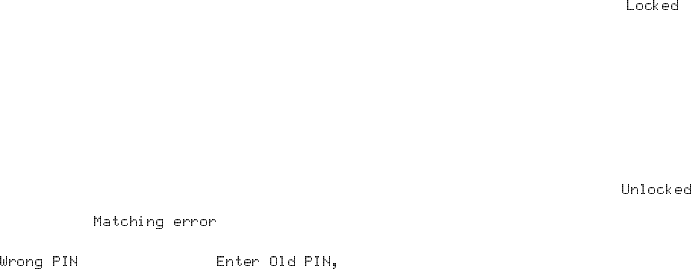
Some menus/features are operator dependent.
Security 49
Unblocking Your SIM Card
1 Press YES.
2 Enter your PUK (or PUK2) which you will find in the
information from your network operator.
3 Enter a new four- to eight-digit PIN (or PIN2).
4 Press
YES.
5 Re-enter the new PIN (or PIN2) to confirm.
6 Press
YES.
Note! If you enter the wrong PUK 10 times in a row, your card
is permanently blocked. If this happens, you should con-
tact your network operator.
Changing PIN
1 Scroll to ACCESS and press YES.
2 Select Card Lock.
3 Select Change PIN code.
4 Enter your old (current) PIN and press YES.
5 Enter your new PIN and press YES.
The phone asks you to repeat the PIN.
6 Enter your new PIN a second time and press YES.
The PIN is now changed.
Note! If the message appears, this means
you entered the new PIN incorrectly. If the message
appears, followed by
you entered your old PIN incorrectly.
Changing PIN 2
1 Scroll to ACCESS and press YES.
2 Select Card Lock.
3 Select Change PIN2 code.
4 Follow the same procedure as described in “Changing
PIN” above.
Activating the SIM Card Lock
1 Scroll to ACCESS and press YES.
2 Select Card Lock.
3 Select Lock card
4 Enter your PIN and press YES.
The message confirms that the card lock is
now activated.
Canceling the SIM Card Lock
1 Scroll to ACCESS and press YES.
2 Select Card Lock.
3 Select Unlock card
4 Enter your PIN and press YES.
The message confirms that the card lock
is now canceled.
Note! This only works if your SIM card allows you to cancel
the card lock.
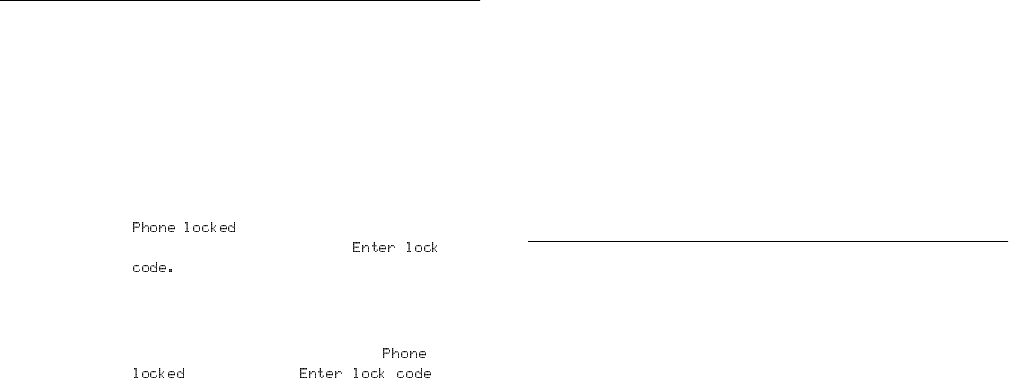
Some menus/features are operator dependent.
50 Security
Phone Lock
The phone lock protects the phone against unauthorized
use if it is stolen and the SIM card exchanged. It is not
activated when you buy the phone. You can change the
default security code 0000 to any three- to eight-digit
personalized code.
The phone lock has two levels: Full Lock and Autolock.
Full Lock
If the Full Lock is activated, you briefly see the message
, each time you turn on the phone. The
message is followed by the prompt
You then have to enter your code followed by
YES to use it.
Autolock
If the Autolock is activated, the message
and the prompt will
appear if you insert a new SIM. After the security code
has been entered correctly, the phone can be used with
the new SIM card. You are not asked to enter the secu-
rity code until the original SIM card or a different SIM
card is inserted.
Changing the Security Code
1 Scroll to ACCESS and press YES.
2 Select Phone lock.
3 Select Change code.
4 Follow the steps described in “Changing PIN”.
Activating/Canceling the Phone Lock
1 Scroll to ACCESS and press YES.
2 Select Phone lock.
The current setting is shown in brackets.
3 Select the setting you want.
4 Enter the security code and press YES.
The new lock status is displayed.
Call Restrict
The Call Restrict service allows you to bar different
types of outgoing and incoming calls.
Note! This service may not be available in all networks or may
require a separate subscription.
The following calls can be restricted:
•all outgoing calls
•all outgoing international calls
•all outgoing international calls except to your home
country when roaming abroad
•all incoming calls
•all incoming calls when you are abroad (when
roaming)
To make sure that a call restrict is not changed by some-
one else, you need a password, which comes with your
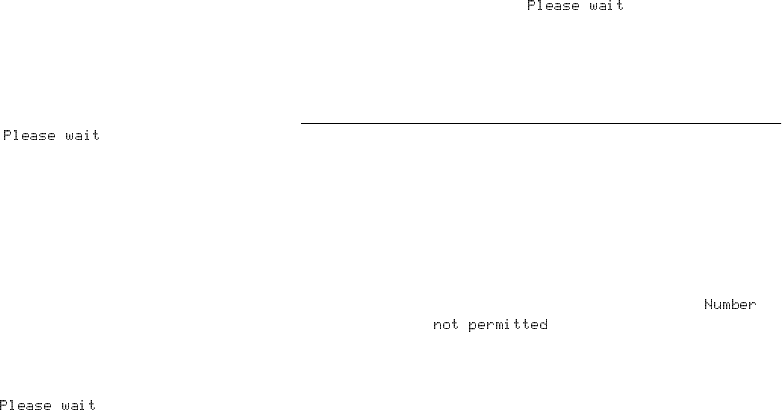
Some menus/features are operator dependent.
Security 51
subscription, to activate or cancel a call restrict. You can
change the password as often as you like.
Changing the Restrict Calls Status
1 Scroll to ACCESS and press YES.
2 Select Call Restrict.
3 Scroll to the option you want and press YES.
4 You have three options:
• Activate sets a call restrict
• Get status lets you check the status of a call restrict
•Cancel cancels the call restrict
5 Confirm your selection by pressing YES.
6 Enter your password and press YES.
The message appears, followed by a
message which informs you whether the call bar is
activated or not.
Note! If you forward incoming calls, you cannot activate some
restricting options. Likewise, if you restrict calls, you
cannot activate some call forward options.
Canceling All Call Restricts
1 Scroll to ACCESS and press YES.
2 Select Call Restrict.
3 Select Cancel all.
4 Enter your password and press YES.
The message appears, followed by a
message confirming that all call restrictions are can-
celled.
Changing the Password
1 Scroll to ACCESS and press YES.
2 Select Call Restrict.
3 Select Change password.
4 Enter the old (current) password and press YES.
5 Enter the new password and press YES.
6 Enter the new password a second time and press YES.
The message appears, followed by a
message confirming that the password has been
changed.
Fixed Dialing
Fixed Dialing is a way of restricting outgoing calls. It
requires a SIM card that allows fixed numbers to be
stored. The fixed numbers are protected by your PIN2.
How many numbers you can store depends on your SIM
card.
The Fixed Dialing function allows calls to be made only
to fixed numbers stored on the SIM card. If an attempt
is made to call other numbers, the message
appears in the display.
It is possible to store partial numbers, for example an
area code, or an area code followed by the first digits
common to several numbers. Storing 919555 allows
calls to be made to numbers from 9195550000 to
9195559999.

Some menus/features are operator dependent.
52 Security
Numbers beginning with the international prefix (+)
and country code can also be stored, allowing you to
make calls abroad.
Numbers which include question marks can be stored.
For example, storing 91955512?? allows calls to be
made to numbers from 9195551200 to 9195551299.
To enter a question mark, press and hold #.
The Fixed Dialing function does not prohibit calls to
the emergency number 911 (or 112) and the Service
Center of your network operator. Network services such
as Call Forward and Calls restrict cannot be used.
Activating Fixed Dialing
1 Scroll to ACCESS and press YES.
2 Select Fixed dialing.
3 Enter your PIN2 and press YES.
4 Select On.
Canceling Fixed Dialing
1 Scroll to ACCESS and press YES.
2 Select Fixed dialing.
3 Enter your PIN2 and press YES.
4 Select Off.
Storing Fixed Numbers
1 Scroll to PHONE BOOK and press YES.
2 Select Fixed numbers.
3 Select Store.
4 Enter your PIN2 and press YES.
5 Enter the name (optional) and the fixed number in the
same way as when storing an ordinary phone number.
Editing a Stored Fixed Number
1 Scroll to PHONE BOOK and press YES.
2 Select Fixed numbers.
3 Select Edit.
4 After you enter your PIN2, you can change the posi-
tion number, the name or the fixed number in the
same way as with an ordinary phone number.
Deleting a Fixed Number
1 Scroll to PHONE BOOK and press YES.
2 Select Fixed numbers.
3 Select Edit.
4 Scroll to the fixed number you want to delete and
press CLR.
appears.
5 Enter your PIN2.
6 Press
YES.
Closed User Groups
The Closed User Groups (CUG) function is a way of
lowering call costs. It depends entirely on your operator
and subscription. Not all networks support the function.
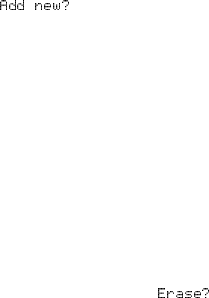
Some menus/features are operator dependent.
Security 53
You can place your most frequently called numbers in
groups. On some networks it is cheaper to make calls
within a call group. You can also make sure that certain
groups can only be called from work, home etc. This
makes it difficult for somebody else to use your phone
for international calls. You can have a maximum of 10
groups.
Selecting a User Group
1 Scroll to ACCESS and press YES.
2 Select Closed calls.
3 Select Group.
4 Select the group you want.
Calls can only be made within the selected user group.
Calling Outside Closed User Groups
1 You can decide whether outgoing calls to a non-CUG
number are allowed.
2 Scroll to ACCESS and press YES.
3 Select Closed calls.
4 Select Open calls.
5 Select Allowed or Not Allowed.
Adding a Name to the CUG List
1 Scroll to ACCESS and press YES.
2 Select Closed calls.
3 Select Edit list.
4 Scroll to the group that you want to edit and press
YES.
5 Scroll to an empty position. The phone prompts you
Press YES.
6 Enter a name. See “Your Phone Book” on page 22.
7 Press
YES.
Erasing a Position from the CUG List
1 Scroll to ACCESS and press YES.
2 Select Closed calls.
3 Select Edit list.
4 Scroll to the group that you want to edit and press
YES.
5 Scroll to the position that you want to erase and press
CLR.
6 The phone prompts you
7 Press
YES.
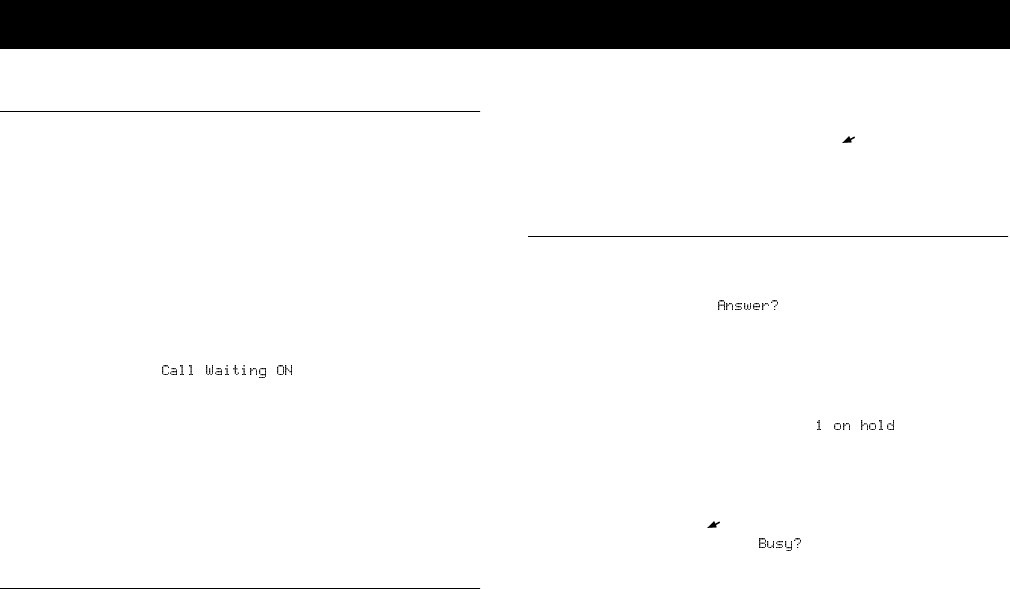
Some menus/features are operator dependent.
54 Handling Multiple Calls
Call Waiting Service
If you wish to be able to receive a second call, while
another call is in progress, you must activate the Call
Waiting service.
Note! The Call Waiting service may not be available in all net-
works.
Activating/Canceling the Call Waiting Service
•Scroll to ACCESS and press YES.
•Select Call waiting.
•Select Activate (or Cancel ).
will appear.
Checking Status of Call Waiting Service
1 Scroll to ACCESS and press YES.
2 Select Call waiting.
3 Select Get status.
Making a Second Call While a Call is
in Progress
1 Put the current call on hold by pressing YES.
2 Enter the number you wish to call and press YES
Note! If the phone number is stored in the phone book, you
do not need to enter it. Press and then recall the
number.
Receiving a Second Call
If the Call waiting service is activated, you will hear a
tone in the earpiece if you receive a second call. The
question appears in the display.
You can do one of the following:
Putting the Current Call On Hold and Answering the
Waiting Call
Press YES. The message appears.
Rejecting the Waiting Call
Press NO or
1 Press .
The question appears.
2 Press
YES.
The waiting call is rejected. If the caller’s network sup-
ports it, the caller will hear a busy tone.
Handling Multiple Calls

Some menus/features are operator dependent.
Handling Multiple Calls 55
Note! If Forward On busy is activated, the waiting call is for-
warded to the number you have specified.
Ending the Current Call and Answering the Waiting Call
1 Press repeatedly until the question
appears.
2 Press
YES.
One Call is Active and One Call Is On Hold
Switching between the Two Calls
Press YES.
Ending the Active Call and Returning to
the Call On Hold
1 Press followed by YES to select the Handle calls
menu.
2 Scroll to Release active? and then press YES.
or
1 Press NO, Retrieve Held Call appears.
2 Press YES to retrieve.
Ending Both Calls
1 Press followed by YES to select the Handle calls
menu.
2 Scroll to Release all calls? and then press YES.
Joining the Two Calls (Call Transfer)
1 Press followed by YES to select the Handle calls
menu.
2 Scroll to Transfer call? and then press YES.
The two calls are now connected to each other, and
you are disconnected from both calls.
Note! The Call Transfer service may not be available on all net-
works.
Joining the Two Calls into a Conference
Call
1 Press followed by YES to select the Handle calls
menu.
2 Select Join calls?.
3 See “Conference Calls” on page 56.
Receiving a Third Call
If the Call Waiting service is activated, you may receive a
third call when you have one active call and a second call
on hold. You hear a tone in the earpiece and the ques-
tion Release and answer?
appears in the display.
You can do one of the following:
Ending the Current Call and Accepting the Waiting Call
Press YES.
The waiting call becomes active and the call on hold
remains on hold.

Some menus/features are operator dependent.
56 Handling Multiple Calls
Rejecting the Waiting Call
Select Busy? using .
The third call is rejected. Provided the caller’s network
supports this function, the caller will hear a busy tone.
Note! If Forward On busy is activated, the waiting call is for-
warded to the number you have specified.
Conference Calls
Note! The Conference Call service may not be available on all
networks.
To create a conference call, you must have one active call
and one call on hold.
Joining the Two Calls into a Conference Call
1 Press followed by YES to select the Handle calls
menu.
2 Select Join calls?.
Adding New Participants to the Conference Group
You can put the conference group on hold and then add
new participants.
1 Press
YES to put the conference group on hold.
2 Call the third person you wish to include in the con-
ference group.
3 Press followed by YES to select the Handle calls
menu.
4 Select Join calls?.
You can include up to five participants, other than your-
self, in the conference group by repeating steps 1 to 4
above.
Reviewing the Participants in the
Conference Group
1 Press followed by YES to select the Handle calls
menu.
2 Scroll to Conference participants and then press YES.
3 The first participant’s phone number is displayed. If
the participant’s number and name is stored in the
phone book, the name is displayed instead.
4 Scroll with to see the other participants’ numbers
(names).
Having a Private Conversation with One Participant
If you wish to have a private conversation with one of
the participants, you can extract that participant from
the conference and put the other participants on hold.
1 Press followed by YES to select the Handle calls
menu.
2 Select the participant you wish to speak in private.

Some menus/features are operator dependent.
Handling Multiple Calls 57
To rejoin the participant to the confer-
ence group
1 Press followed by YES to select the Handle calls
menu.
2 Select Join calls?.
Releasing Participants from the Conference Group
You can release participants from the conference group.
1 Press followed by YES to select the Handle calls
menu.
2 Select the participant you wish to release.
Making a Call while a Conference Call Is in Progress
You can put the conference group on hold and make
another call. You can then switch between the new call
and the conference call.
1 To put the conference group on hold, press YES.
2 Enter the number you wish to call and press YES.
Switching Between the New Call and the
Conference Group
Press YES.
Ending the New Call and Returning to
the Conference Group
1 Put the conference group on hold.
2 Press followed by YES to select the Handle calls
menu.
3 Select Release active?.
Ending the Conference Call
Close the flip or press NO.

Some menus/features are operator dependent.
58 Networks
Searching for Networks
When you turn on the phone, it searches for the last
accessed network. If this is not within range, you may
use another network, provided your home network has
an agreement that allows you to do so. This is called
Roaming.
The order of preference in which the phone selects a net-
work is determined by a list of preferred networks on
your SIM card.
The NETWORKS menu includes a number of func-
tions that let you determine how the phone searches for
a network. You may also select a network yourself from
those within range.
Selecting a New Network
1 Scroll to NETWORKS, and press YES.
2 Select Select net.
3 The message is displayed briefly. The
display then shows either:
•the name of a network, followed by the message
Current, Preferred, Available, or Forbidden. For an
explanation of the message, see the table.
Instead of the full name of a network, an abbrevia-
tion may be displayed. To see the full name of a net-
work, press *.
•the message indicates that no net-
work is within range.
4 If there is more than one network within range, you
can scroll through the network names and choose the
network you want by pressing YES
Networks
Message Meaning
The network is currently being used.
Your home network is within range. You can
select it.
The name of the network is included in a list of
preferred networks on your SIM card. You can
select this network.
The name of the network is included in a list of
forbidden networks on your SIM card. You can
normally not select this network. See “List of
Preferred Networks” on page 59.

Some menus/features are operator dependent.
Networks 59
Starting an Automatic Network Search
1 Scroll to NETWORKS and press YES.
2 Select New search.
The phone automatically starts searching for a net-
work according to the list of preferred networks stored
on your SIM card.
List of Forbidden Networks
The names of the forbidden networks are stored on your
SIM card. If such a forbidden network is within range, it
is left out when the phone searches for a network (auto-
matic search mode).
If your home network and a forbidden network come to
an agreement that allows you to use the forbidden net-
work, you can select this network even though the mes-
sage is displayed.
List of Preferred Networks
You can create a list that defines in which order your
phone will select a network during automatic network
selection, when your home network is not within range.
The number of networks that can be stored in the list
depends on your SIM card.
The Edit list function lets you review the networks in
the list. Apart from rearranging the order of the net-
works, you can add new networks to the list and delete
networks from it.
Reviewing the List of Networks
1 Scroll to NETWORKS and press YES.
2 Select Edit list.
3 The name of the first network is displayed.
4 Scroll through the networks in the list.
Note! To see a network’s full name, press *.
Adding a Network to the List
1 Scroll to NETWORKS and press YES.
2 Select Edit list.
3 Scroll to the first free position in the list and press
YES.
The prompt appears.
4 If you scroll to a position that is already occupied,
press YES and then scroll with the arrow keys until
appears.
The name of the network is not included in the
preferred or forbidden list on your SIM card.
You can select this network, but you might not
be able to use it.
Message Meaning
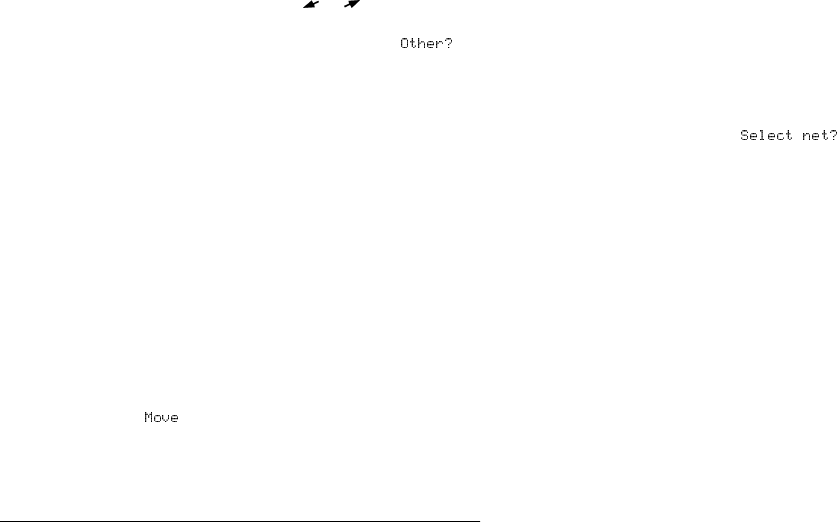
Some menus/features are operator dependent.
60 Networks
5 Press
YES and scroll with or until you find the
network that you want. If the desired network does
not appear, press YES when the question
appears.
6 Enter the three-digit country number and the two- or
three-digit network number.
7 Press YES to add the network to the list.
Erasing a Network from the List
1 Scroll to NETWORKS and press YES.
2 Select Edit list.
3 Select the network you wish to erase.
4 Scroll to Erase and press YES.
Re-arranging the List
1 Scroll to NETWORKS and press YES.
2 Select Edit list.
3 Select the network you wish to move.
is displayed.
4 Press
YES and enter the new position within the list.
Search Modes
When you turn on your phone, it searches for a net-
work. This can be done in two different ways, depend-
ing on the search mode that is activated. Automatic
search mode is usually the default.
Automatic search mode means that your phone searches
for the last accessed network first. If this is not available,
it automatically searches for another available network
within range.
Manual search mode means that your phone searches
for the last accessed network first. If this is not available,
the question appears.
•Select a network as described in “Selecting a New
Network”.
Activating Automatic Search Mode
1 Scroll to
NETWORKS and press YES.
2 Select Search mode.
3 Select Auto.
Activating Manual Search Mode
1 Scroll to NETWORKS and press YES.
2 Select Search mode.
3 Select Manua
l
.
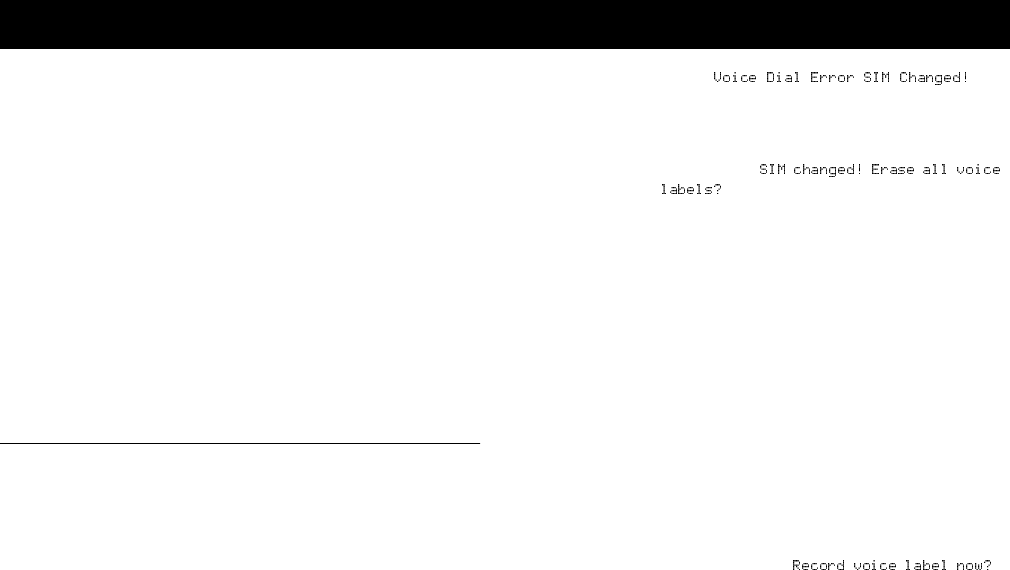
Some menus/features are operator dependent.
Voice Activation 61
The phone is equipped with a built-in voice recognition
system known as Voice Activation.
This system allows you to:
•voice dial
•answer and reject calls.
To call someone, you only need to press the upper side
volume key or YES, say the voice label associated with
that person and the phone automatically dials his or her
number. To answer and reject calls, you only need to say
for example “Answer” and “Busy”.
Note! Best performance is obtained by holding the phone as
you would when on a call, with the phone up to your
ear, the flip down, and in a silent environment.
Recording Voice Dialing Labels
You can record (save) a voice label together with a name
and number in your phone book. The voice label and
the name do not have to match. That is, you can store a
number with the name “Home” (that is what you see in
the display when searching for a number in your phone
book), but your voice label might be “Jenny”. The voice
labels are stored on your phone. You will need to record
new voice labels if you change phones. You will also need
to record new voice labels if you change SIM cards. The
message will
appear when you insert a new SIM and attempt to acti-
vate the Voice Dial feature.
If you insert a new SIM card and attempt to record a
new voice label,
will appear. Press NO to keep the original
labels.
Note! Your phone can hold up to 10 different voice labels.
Activating the Voice Dialing function
1 Scroll to SETTINGS and press YES.
2 Select
Voice dial.
3 Select
On.
Adding a Voice Dialing Label to an Existing Phone Book
Entry
1 Scroll to PHONE BOOK and press YES.
2 Select Edit.
3 Scroll Find name or Find pos.
4 Enter the name you want to add a voice label to and
press YES.
After a few seconds is
displayed.
5 Press
YES again to store.
Voice Activation

Some menus/features are operator dependent.
62 Voice Activation
6 Press
YES. You are prompted to speak after a tone
(beep).
7 Say the voice label that you want to be stored with the
phone book entry. The voice label is played back to
you.
8 If you are satisfied, press YES to store the voice label.
Otherwise, press NO and then repeat steps 2 and 3.
The voice label icon appears next to the posi-
tion number .
Creating a Voice Dialing Label and New Phone Book
Entry
Note! For more information, refer to “Your Phone Book” on
page 22”.
1 Enter the area code and phone number you wish to
store.
2 Scroll to PHONE BOOK and press YES.
3 Select Store.
The first free memory position is suggested.
4 Enter the name tag that you want to associate with the
number.
5 Press
YES. appears.
6 Press
YES to record.
7 Say the voice label after the tone. The voice label is
played back to you.
8 If you are satisfied, press YES to store the voice label.
Otherwise, press NO and follow the prompts.
Once stored in your phone book, the voice label icon
appears next to the position number.
Recording Problems
If the phone could not detect any speech, one of the
following might have happened:
•the name of the voice label was too short.
•the background noise of your recording location
was too loud.
•you spoke too softly.
•you spoke before the beep.
Try to change one of these factors and repeat “Adding
a Voice Dialing Label to an Existing Phone Book
Entry” or “Creating a Voice Dialing Label and New
Phone Book Entry”.
Replacing a Voice Dialing Label
1 Scroll to PHONE BOOK and press YES.
2 Select Edit.
3 Scroll to Find name or Find pos.
4 Enter the name with the voice label you want to
replace and press YES. The name and number is dis-
played and the label is played.
5 Press YES to select.
After a few seconds,
is dis-
played.
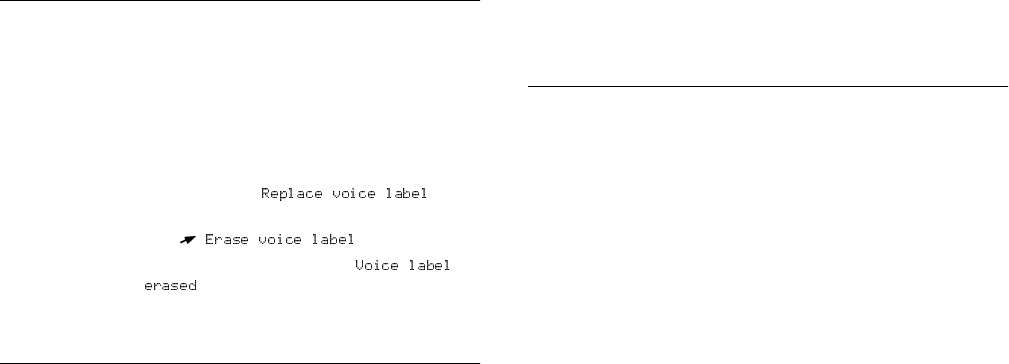
Some menus/features are operator dependent.
Voice Activation 63
6 Press
YES. Then follow the phone’s prompts.
Erasing a Voice Dialing Label
1 Scroll to PHONE BOOK and press YES.
2 Select Edit.
3 Scroll to Find name or Find pos.
4 Enter the name with the voice label you want to erase
and press YES. The name and number is displayed
and the voice label is played.
5 Press
YES to select.
After a short while
is dis-
played.
6 Press . is displayed.
7 Press
YES to erase the voice label.
appears.
Voice Label List
If the Voice Dialing function is on, the PHONE
BOOK menu includes a Voice Label list. When
selected, you can scroll through the names and numbers
which have a voice label attached. When such a number
is displayed, its voice label is played back. You can call
the number by pressing YES.
Selecting the Voice Label List
1 Scroll to PHONE BOOK and press YES.
2 Select Voice label list.
3 Scroll through the list to hear the labels.
Using Voice Dialing
Once you have recorded your voice labels and the Voice
Dialing function is on, you can start using the Voice
Dialing system. It is actually very easy to use.
Making a Call While Handheld
1 Open the flip.
2 Clear the display using CLR.
3 Press and hold the YES key, or the press the upper side
VOLUME key briefly
4 Say the voice label after the prompt.
Calling While in Handsfree
1 Press the upper side VOLUME key or YES briefly.
2 Say the voice label after the prompt.
Note! Voice Dialing will work with the flip opened or closed
when in Handsfree mode. Closing the flip will not ter-
minate the call when in Handsfree.

Some menus/features are operator dependent.
64 Voice Activation
Recording the Voice Answering Labels
The words that you choose to accept and reject calls can
be any word in any language, but the recording time is
limited. Try to make the words unique and not too
short. In the example below, we have chosen the com-
mands “Answer” to accept and “Busy” to reject incom-
ing calls.
The first time you turn the phone’s Voice Commander
on, you are asked to train it. You start the training by
saying a command (voice label) for accepting, then you
continue with a command for rejecting.
Initially Activating and Training the Voice Commander
1 Scroll to SETTINGS and press YES.
2 Select Voice ans, On.
3 Wait three seconds and the question
appears.
4 Press
YES.
You start by training the voice commander to recog-
nize the command for accepting calls.
5 Say the command you want to use.
The command is played back to you.
6 If you are satisfied, press YES to save the command
(voice label). Otherwise, press NO and then repeat the
process.
7 The phone now prompts you to enter a voice com-
mand for rejecting calls:
. Follow the phone’s prompts. Be sure that you
have two different words for accepting or rejecting.
Replacing the Voice Answering Labels
1 Scroll to SETTINGS and press YES.
2 Select Voice answer.
3 Select Replace voice label.
4 Wait three seconds and the question
appears.
5 Follow the phone’s prompts.
Answering or Rejecting a Call Using Voice
Activation
Be certain the Voice answer option in SETTINGS
menu is activated. The phone’s flip must be opened or
the phone must be attached to an Ericsson Handsfree
accessory to use this feature. When you receive an
incoming call, clearly say the voice command that you
have recorded.

Some menus/features are operator dependent.
Extra Features 65
Call Time and Call Cost
Call Information
The display shows the duration of a call in progress.
When you end the call, the call duration information is
shown for another five seconds. If your network and
SIM card support this feature, you can have the call cost
(or the number of call units) displayed.
Selecting the call information you want
1 Scroll to SETTINGS and press YES.
2 Select Call info.
3 Select Time: Outg, Time: All or Cost.
Checking the time/cost of the last call
1 Scroll to INFO and press YES.
2 Select Last call.
Depending on the setting in the Call info function in
the SETTINGS menu, you can now check:
•how long your last call was (Time: Outg or Time:
All)
•the cost (or the number of call units) of the last call
(Cost).
Total Call Time or Call Cost
Checking the total call time or call cost
1 Scroll to INFO and press YES.
2 Select Tot calls.
3 Depending on the setting in the Call info function in
the SETTINGS menu, you can check:
•the total time of all outgoing calls (Time: Outg)
•the total time of all calls (Time: All)
•the cost (or the number of call units) of all calls
(Cost)
Resetting the total call time/cost counter
1 Scroll to INFO and press YES.
2 Select Tot calls.
3 Select Reset?.
Note! If you have chosen the call cost option, you must enter
your PIN2 to reset the counter.
Determining the Call Cost
If you select the Cost option in the Call info function in
the SETTINGS menu, the Price function appears in the
INFO
menu. However, to be able to use the Price func-
Extra Features

Some menus/features are operator dependent.
66 Extra Features
tion, both your network and your SIM card must sup-
port it.
The Price function lets you enter and vary the price per
call unit. The price entered is stored on your SIM card.
Note! If you do not specify a price per call unit, the number of
call units will be displayed during a call, and in the Last
call and Tot calls functions.
Entering the Price Per Call Unit
1 Scroll to INFO and press YES.
2 Select Price.
3 Select New price.
4 Enter the code for the currency you want, for example
USD for U.S. Dollars, and then press YES.
5 Enter the price per call unit, for example 0.75, and
press YES. To enter the decimal point, press #.
6 Enter your PIN2 and then press YES. (The PIN2
prompt may not appear in some networks.)
Reverting to Call Units
1 Scroll to INFO and press YES.
2 Select Price.
3 Select New price.
4 Enter your PIN2 and then press YES.
Credit Limit for Calls
If both your network and SIM card support this feature,
you can enter a total amount of money that can be used
for making calls. This could be useful when you lend
your phone to someone, for example, and do not want
their call costs to exceed an amount specified by you.
The cost is deducted from this amount while you are
engaged in a call. When the amount reaches zero, no
more calls can be made.
Setting the Credit Limit
1 Scroll to INFO and press YES.
2 Select Credit.
3 Select New credit.
4 Enter the amount, for example 20 dollars ($20.00),
and then press YES.
5 Enter your PIN2 and then press YES.
Calling Card or Credit Card Calls
When making international or long distance calls, you
may not want your operator to charge you on your nor-
mal account. If you have a credit card or a calling card,
you may want to re-direct the charges to one of those
accounts instead. Your phone is all set for making this
procedure as easy as possible for you.

Some menus/features are operator dependent.
Extra Features 67
Note! The Calling Card and Credit Card Call feature is net-
work dependent.
Activating the Calling Card Feature
1 Scroll to ACCESS and press YES.
2 Select Call cards security.
3 Enter your security code and press YES.
4 Scroll to Call cards, YES, On, YES.
The Call card function is now activated and the sub-
menu Call card numbers is visible in the PHONE
BOOK menu.
Changing Security Codes
1 Scroll to ACCESS and press YES.
2 Select Call cards security.
3 Enter your security code and press YES.
4 Scroll to Change code and press YES.
5 Enter your new code and press YES.
The code can consist of four to eight digits.
6 When appears in the display,
confirm your new code.
7 Press
YES.
Your security code is now changed.
Storing Credit or Calling Card Numbers
Your phone allows you to store two calling card numbers
in the PHONE BOOK menu. This sub-menu is only
visible if the Call card function is activated in the
ACCESS menu.
Storing a Calling Card Number:
1 Scroll to PHONE BOOK and press YES.
2 Select Call card numbers.
3 Enter your security code and press YES.
To change security codes, see above.
4 Select card position (Card 1 or Card 2).
5 Enter the access number (the phone number) to the
calling card server. The numbers are entered in the
same way as in the ordinary phone book.
6 Press or .
7 Enter the verification code to your calling card server.
8 To store the calling card number, press YES.
9 Select Call no. then Ver no. or Ver no. then Called no.
Selecting a Card
If you have stored two card numbers, you must select
which card you wish to use before making a Calling/
Credit card call.
1 Scroll to PHONE BOOK and press YES.
2 Select Call card numbers.
3 Enter your security code and press YES.
4 Scroll to the card you wish to use.
Your settings for the card appear. To select the card,
press YES.
Note! If you only use one card number, this selection does not
have to be repeated every time you wish to make a Call-
ing/Credit card call.
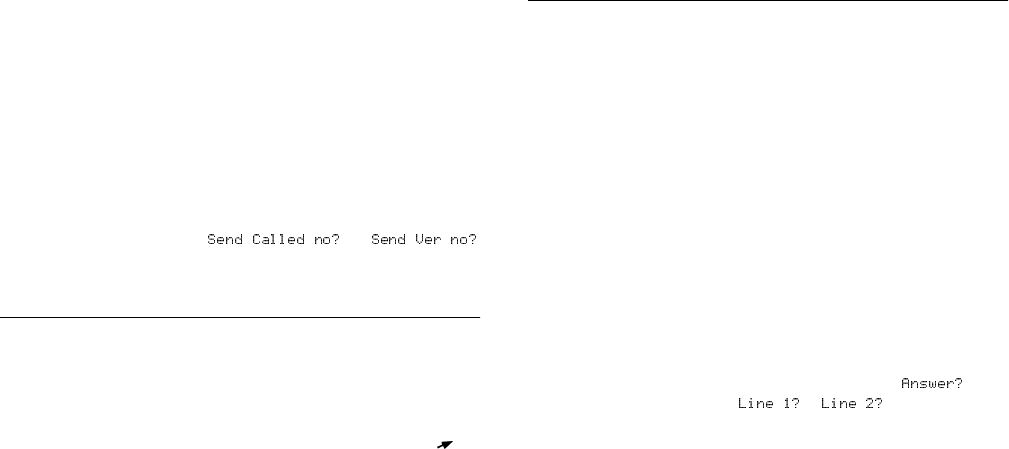
Some menus/features are operator dependent.
68 Extra Features
Making a Credit or Calling Card Call
1 Enter the number you wish to dial, or retrieve it from
the PHONE BOOK.
2 Press and hold YES.
The access number to the calling card server is called and
during the connecting phase, you are prompted to send
the called number (the number or the person you want
to call) and the verification code, in the order chosen by
you (see above).
To send the called number and the verification code
during the connecting phase, press YES when the dis-
play shows and
Editing or Deleting a Calling Card Number
1 Select PHONE BOOK menu.
2 Select Call card numbers and enter your security code
when prompted.
3 Select Card1 or Card2.
4 Press and hold CLR to clear the entire line. Use to
move to the next line. Press and hold CLR to clear this
line.
5 Press YES to store your change.
Using Two Voice Lines
Note! This service may not be available on all networks and
may require a separate subscription.
Your phone supports two voice lines ALS with different
phone numbers, Line 1 and Line 2. This is useful if you
want to keep business calls and private calls on separate
lines. You can only send and receive text messages (SMS)
on Line 1.
The line currently selected is indicated in the display
with a line indicator and the digit
1
or
2.
Changing to the Other Line
•Scroll to Change to Line X and press YES.
From now on, all outgoing calls are made on the
line you just selected.
Receiving a Call on One of the Lines
When someone calls you, the question is
replaced by or depending on
which line the person is calling.
Note! If you are on a call on one line, you must end that call
first before answering a call on the other line (dependent
on the activation of the Call Wait function).
Different Settings for Each Line
You can personalize the names of the two lines. You can
also have different settings for each line, for example: the
tone of the ring signal, call forwards, call bars and call

Some menus/features are operator dependent.
Extra Features 69
waiting. You set these functions separately when the line
is activated. The call meters in the INFO menu show
the call times (call costs) for the line currently selected.
Changing the Name of a Line
1 Scroll to SETTINGS and press YES.
2 Select Line 1 Tag (or Line 2 Tag).
3 Enter a new name (maximum 12 characters).
4 Press
YES.
Note! The name tag is only shown in Alternate Line Service
menu and during an incoming call.
Calling from Your Car
By using the Ericsson portable or vehicle handsfree solu-
tions, you can be on the phone without using your
hands to hold it.
Handsfree Types
If you use a Vehicle Handsfree Solution, you can choose
between two different ways in which your phone can
handle the speech. This is done in the Handsfree sub-
menu.
Handsfree Type 1
Handsfree Type 1 means that the phone handles the call
in semi-duplex mode. This means that you cannot speak
at the same time as the person at the other end of the
line. Use this alternative only if Type 2 does not work
properly.
Handsfree Type 2
Handsfree Type 2 means that the phone handles the call
in full duplex mode. This considerably increases the
quality of speech, since you do not have to wait until it is
your turn to speak, and the speech becomes clearer.
For Handsfree Type 2 to work properly, your phone
adapts to the sound environment around the handsfree
equipment. This adaptation might take a few calls. Dur-
ing this learning phase, the person you are talking to
might hear an echo of his or her own voice (because the
sound goes from the speaker into the microphone
again). However, this disappears as the other person
speaks. If the echo lasts longer than the first few calls, try
Handsfree Type 1 instead.
Note! More sophisticated Vehicle Handsfree solutions auto-
matically provide full duplex. They also disable the
choice between Handsfree Type 1 and 2, since the
choice becomes superfluous when using this kind of
equipment; you always get the best quality of speech
possible.
Setting the Handsfree Type
1 Scroll to SETTINGS and press YES.
2 Select Handsfree.
3 Select the type you want.

Some menus/features are operator dependent.
70 Extra Features
Other Handsfree-Related Settings
Apart from the settings mentioned above, you can
change the following settings when using handsfree
equipment:
•Ring level
•Ear volume
•Ring type
•Display light
Each of these settings can be specified separately when
you have your phone connected to handsfree equip-
ment. This means that if you choose one of these set-
tings when the phone is connected to handsfree
equipment, the settings when it is handheld are not
affected and vice versa.
Changing a Setting
1 Connect the phone to the handsfree equipment.
2 Change the setting according to the instructions in
“Personalizing Your Phone” on page 30.
Answering Mode
The submenu Answering mode, in the SETTINGS
menu, includes two functions: Any key and Auto, which
are useful when you use the phone with handsfree equip-
ment.
•Any key: If you use the phone with handsfree
equipment and this function is turned on, you can
answer an incoming call by pressing any key, except
the NO key.
•Auto: If you choose the automatic answering mode,
an incoming call is answered automatically after one
ring signal.
Selecting Answering Mode
1 Scroll to SETTINGS and press YES.
2 Select Answering mode.
3 Select a mode.
Sending and Receiving Faxes and Data
If you have a SIM card that does not support separate
fax and data numbers, you need to activate the data
menus. When the DATA menus are activated, a new
menu appears in your phone: NEXT CALL TYPE.
Note! An authorized Ericsson modem and a PC are required to
support Data and Fax transmission.
Activating the Data Menus
1 Scroll to SETTINGS and press YES.
2 Select Data Menus.
3 Select On.

Some menus/features are operator dependent.
Extra Features 71
Next Call Type
This function allows you to decide which type the next
incoming call will be, i.e. fax, data, or speech. You will
only see this menu if your phone detects that you do not
have separate numbers for data, fax and speech. Once
you have set your phone for a specific incoming call, it
will stay so until you change it back. The normal setting
is Speech.
Defining the Next Incoming Call
1 Scroll to NEXT CALL TYPE and press YES.
2 Select which type the next incoming call will be.
Alarm
The phone has an alarm function. When it is activated,
an icon in the shape of a bell is shown next to the cur-
rent time in the display.
The alarm signal sounds at the time set, even if the
phone is turned off. The keys will illuminate and the
display will flash. The volume of the alarm signal
depends on the setting of the ring signal.
The alarm signal will sound for 60 seconds and will be
repeated every nine minutes, if you do not turn it off.
After 60 minutes, the repeat function will be turned off
automatically.
Setting the Alarm
1 Scroll to TO OL S and press YES.
2 Select Set alarm.
3 Enter the time in hours and minutes.
If you have selected the 12-hour format in the Clock/
Date function in the SETTINGS menu, you can
alternate between am and pm by pressing #.
4 Press
YES.
Turning Off the Alarm
1 Press any key to turn the alarm signal off when it
sounds.
2 If you do not want the alarm to be repeated, press
YES.
3 Press
NO to snooze.
or
1Scroll to TOOL S and press YES.
2 Select Set alarm, Off.
Calculator
The phone’s built-in calculator can add, subtract, divide,
and multiply.
Using the Calculator
In this example we are going to divide 134 by 32.

Some menus/features are operator dependent.
72 Extra Features
1 Scroll to TOOL S and press YES.
2 Select CALCULATOR.
3 Enter 134.
4 Scroll with to the division sign (/) and press
YES.
5 Enter 32.
6 Scroll with the to the equal sign (=) and press
YES.
You can also press # to get the answer.
7 To clear the display, press CLR.
Entering a Decimal Point
Press *.
Entering the Multiplication Sign (*)
Press * twice.
Quick Keys
Several keys on your phone can be used to optimize the
phone’s functionality and decrease the number of times
you need to press a key. Some of the key combinations
demand that your phone is in a certain mode and some
can be made from the standby mode.
The table below describes some of the most useful key
combinations.
To… Do this: Mode:
mute the
microphone press and hold CLR when on the
phone
quickly access
voicemail press and hold the 1 key when in standby
quickly access phone
book alphabetically
(only available for
keys 2-9)
press and hold the 2 key to
access letters A-C
press and hold the 3 key to
access letters D-F
Use to scroll.
when in standby
reach second letter
press and hold the upper
volume key and press the
desired numeric key
when entering
letters
reach third letter
press and hold the lower
volume key and press the
desired numeric key
when entering
letters
reject a call
double-click on either
volume key or press 0 and
YES
when receiving a
call
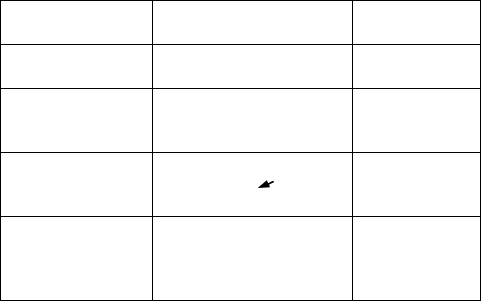
Some menus/features are operator dependent.
Extra Features 73
speed dial press 1 – 9 and YES when in standby
move three lines
forward press 3when reading a
message
return to beginning
of message press and hold when reading a
message
mute ringer
press and hold CLR
press and hold again to
release
in standby
To… Do this: Mode:

Some menus/features are operator dependent.
74 Troubleshooting
This chapter lists some problems that you might
encounter while using your phone. Some problems
require that you call your service provider, but most of
the problems you encounter are easy to correct yourself.
Error Messages
Insert card
There is no SIM card in the phone. Insert a SIM Card.
Searching
If the message remains in the display, you
are within range of a network but you are not allowed to
use it. However, in an emergency, some operators allow
you to call the emergency number 911 (or 112). See
“Making Emergency Calls” on page 19.
No network
There is no network within range or the received signal
is too weak. You have to move to get a signal that is
strong enough.
Wrong PIN, Wrong PIN2
You entered your PIN or PIN2 incorrectly.
Enter the correct PIN or PIN2, and press YES. Your
SIM will be blocked after three unsuccessful attempts.
Matching error
When you want to change a security code (for example
PIN) you have to confirm the new code by entering it
again. The two codes that you have entered do not
match. See “The SIM Card Lock” on page 48.
PIN/PIN2 Blocked. Unblock?
You entered your PIN or PIN2 incorrectly three times
consecutively. To unblock see “The SIM Card Lock” on
page 48.
BLOCKED Contact card provider
You entered your PUK incorrectly 10 times consecu-
tively. Contact your network provider or service opera-
tor.
Phone locked
The phone is locked. To unlock the phone, see “Phone
Lock” on page 50.
Enter lock code
Your phone comes with the default security code, 0000.
You can change it to any three- to eight-digit personal-
ized code. See “Phone Lock” on page 50.
Troubleshooting

Some menus/features are operator dependent.
Troubleshooting 75
Number not permitted
•The Closed User Groups function is activated and
the number you have dialed is not part of a group.
See “Closed User Groups” on page 52.
•You have Fixed Dialing Numbers activated, but you
have dialed a number that is not permitted on the
Fixed Dialing Numbers list.
Phone Does not Come On
Handheld Phone
Recharge or replace the battery.
Handsfree Phone in Vehicle
Make sure that the phone is properly inserted into its
holder.
Poor Sound Quality in Handsfree Equipment
•Check that the handsfree equipment is Ericsson
original equipment and that it has been properly
installed,
•Change the Handsfree Type from Type 1 to Type 2.
See “Handsfree Types” on page 69.
Voice Answering Does Not Perform Well
Try changing the voice labels for accepting and rejecting
calls.
Voice Recording Problems
•The name of the voice label was too short.
•The background noise of your recording location
was too loud.
•You spoke too softly.
•You spoke before the beep.
Try to improve one of these elements when you repeat
the voice label recording process.
Technical Support
If you need additional information or assistance, or
would like to purchase Original Ericsson Accessories: in
North America call 1-800-ERICSSON (374-2776) ; in
Latin America call 305-755-6789 ; all other countries
call 919-472-7908.

Some menus/features are operator dependent.
76 Terminology
Acronym List
Glossary
Active Flip
This factory default feature allows you to easily answer
and end calls without the use of the keypad.
Advice of Charge (AoC)
Enables you to monitor the cost of calls made from your
mobile phone. Details of the last call and total calls
made are shown in the phone display.
Alternate Line Service (ALS)
Enables you to have two lines and two different phone
numbers on one subscription for your mobile phone.
This makes it possible to have separate numbers for
business and personal calls. To use this service, it must
be supported by your network.
Area Information
A service that allows you to receive messages about pre-
set topics i.e. weather forecasts, road reports, etc. To use
this service, it must be supported by your network.
Calling Line Identification (CLI)
Shows the number of the person calling you in your
mobile phone display. You can then make an informed
choice as to whether or not to take the call. Bear in mind
that not all numbers can be displayed. To use this ser-
vice, it must be supported by your network.
Terminology
AoC Advice of Charge
ALS Alternate Line Service
CLI Caller Line Identification
DTMF Dual Tone Multiple Frequency
GSM 1900 Global System for Mobile Communication (1900 MHz)
PIN Personal Identification Number
PUK Personal Unblocking Key
SIM Subscriber Identity Module
SMS Short Message Service
Some menus/features are operator dependent.
Terminology 77
Ciphering
Ciphering is a built-in feature that “scrambles” your calls
and messages to provide additional privacy. An exclama-
tion point next to the phone icon during a call indicates
that ciphering is currently not available from the service
provider.
Closed User Groups
This feature limits outgoing calls to specified numbers.
This can be very useful when operators give lower rates
for specific groups. To use this service, it must be sup-
ported by your SIM.
DTMF or Touch Tone
Dual Tone Multi Frequency signal – codes sent as tone
signals. Used for telephone banking, for accessing an
answering machine, etc.
Fax Class
Standards for fax transmission are set as classes. Class I
and II allow data transfer speeds of between 2400 up to
9600 bps.
Fixed Dialing Numbers
Enables you to allow only numbers beginning with cer-
tain pre-defined figures to be dialed from your mobile
phone. The service is activated by PIN2. To use this ser-
vice, it must be supported by your SIM.
Forward
Enables you to forward calls to another number, for
example your voicemail or home phone.
Full Duplex
In handsfree equipment, means that both parties on the
phone can talk at the same time.
GSM 1900
Also known as PCS 1900, is a digital network working
on a frequency of 1900 MHz. It is used in the United
States, Canada, and some Latin American countries.
Handsfree
An important safety feature for mobile phones that
allows drivers to use their car phone without lifting or
holding the handset to their ear.
International Prefix (+)
Mobile phone (+) prefix that automatically adds the cor-
rect international code in front of a telephone number
when dialling out of a country. You then have to add the
code of the country you are calling.
Some menus/features are operator dependent.
78 Terminology
Line 1/Line 2
See “Alternate Line Service” on the previous page.
Menu System
The easiest way to access all the phone’s functions. The
menus are arranged to be accessed and viewed when
scrolling with the arrow keys.
Network
A mobile phone network or system consists of a network
of cells. A radio base station serves each cell from where
calls are forwarded to and received from your mobile
phone by wireless radio signals.
Operator
To be able to use your phone, you need a subscription to
a network. You get this subscription from a network
operator, together with a SIM card that you need to use
with your phone.
Phone Book
A memory in your mobile phone where phone numbers
can be stored and accessed by name (alpha memory
search) or position.
PC-Card
Also called PCMCIA, the PC-card can act as a modem
and connect your mobile phone to a laptop or organizer,
enabling data and fax transmission. The thin type II card
is the most common size. Type III is a thicker card and
can house more than modem functionality.
PIN
Personal Identification Number – a code used for all
GSM-based phones to establish authorization for access
to certain functions or information. The PIN code
comes with your subscription.
PIN2
Personal Identification Number 2 – an authorization
code which is used only for special services.
PUK
Personal Unblocking Key – used to unlock a blocked
SIM card. This comes with your subscription.
Restrict Calls
Enables you to restrict certain or all types of calls to and
from your mobile phone, i.e. outgoing calls, outgoing
international calls, incoming calls. Restricting is acti-
vated with a personal code. To use this service, it must
be supported by your network.
Roaming
You are outside of your home network.
Semi-Duplex
In handsfree equipment, full duplex means that the con-
nection is open for both parties to talk simultaneously.

Some menus/features are operator dependent.
Terminology 79
Semi-duplex gives close to, but not complete, duplex
functionality.
Service Provider
A company that provides services and subscriptions to
mobile phone users.
Short Message Service (SMS)
Allows messages of up to 160 characters to be sent and
received via the network operator’s message center to
your mobile phone. Messages are stored if the phone is
off or out of reach ensuring that they reach you. To use
this service, it must be supported by your network.
Scroll
Pressing or to move between the menus.
Select
Scrolling to a menu then pressing the YES key on the
phone.
SIM Card
Subscriber Identity Module card – a card that must be
inserted in any GSM-based mobile phone. It contains
subscriber details, security information and memory for
a personal directory of numbers. The card can be a small
plug-in type or credit card sized but both types have the
same functionality.
Standby
The mode where your phone has been cleared of all
menu items and features. If there is no action within a
minute, the phone will automatically revert to standby.
Subscription
Is the contract that you have with the service/network
provider. To use your phone, you need to have a sub-
scription to a network. You get a SIM (Subscriber Iden-
tity Module) card with your subscription. The services
included in your subscription depend on your choice of
operator and/or subscription. So some of the services
and functions described in this manual may not be
accessible to you. If you want a complete list of the ser-
vices included in your subscription, please contact your
network operator.
Voicemail
A computerized answering service that automatically
answers your call, plays a greeting in your own voice and
records a message.
Voice Activation
A feature that allows a subscriber to place a call or
answer a call by spoken commands.
Voice Recognition
The capability for mobile phones, PCs, and other com-
munications devices to be activated or controlled by
voice commands.
Some menus/features are operator dependent.
80 Terminology

Some menus/features are operator dependent.
81
A
Alternate Line Service (ALS)68
Answered calls indicator27
Answering calls19
Area information43
message types43
receiving area messages44
Auto Store35
B
Battery11
attaching11
charging1112
recycling8
Battery charger12
Blasting6
C
Calculator71
Call cost
specifying price per unit65
Call forward
activating46
canceling47
checking status47
forward indicator46
Call list27
activating28
Call Restricting
changing status51
Call waiting54
Call waiting service
activating54
Calling
from phone book25
Calls
answering19
ending19
putting on hold20545657
receiving19
redialing18
rejecting20
switching between calls55
CB. See Area information
Cell broadcast. See Area information
Changing PIN49
Children6
Clock. See Time
Closed user groups52
Conference calls56
adding new participants56
Credit cards66
D
Date35
Dialed numbers indicator27
Display
greeting text33
language33
light33
DTMF tones21
E
Earpiece
volume20
Embedded Numbers40
Emergency calls19
Ending calls19
Entering Special Characters22
Error messages74
F
Fax, sending and receiving70
Fixed dialing51
activating52
canceling52
Fixed numbers52
editing52
storing52
Index
Some menus/features are operator dependent.
82
Flip151957
Forbidden networks59
Forward indicator46
G
Greeting text in the display33
H
Handsfree usage69
I
Indicators in display27
answered calls27
dialed numbers27
missed calls27
phone icon22
International calls19
International emergency number19
K
Key functions15
Key sound33
Keypad
unlocking48
Keypad lock48
L
Language in the display33
Letters, entering22
M
Master Reset35
Memory full24
Message signal33
Message types (SMS)38
Microphone
muting20
Minute minder32
Missed calls28
Missed calls indicator27
Muting microphone20
N
Name recall25
Network58
forbidden59
preferred59
search modes60
selection58
Numbers, Embedded40
P
Pacemakers6
Personal ring signal31
Phone Book
auto store35
calling from25
changing a name26
changing phone number25
erasing phone number24
keeping up to date25
Phone icon22
Phone lock50
auto lock50
full lock50
Phone number
displaying own34
PIN
changing49
PIN213
changing49
Plus sign (+)19
Position recall25
Preferred networks59
PUK49
Q
Quick dialing. See Speed dialing
R
Receive calls19
Receiving messages (SMS)39
Redialing numbers18
Rejecting calls20
Request reply (SMS)38
Restrict Calls50
canceling all51
changing password51
Some menus/features are operator dependent.
83
changing status51
Ring signal
choosing31
composing own32
level30
personal31
type30
S
Safety Guidelines5
Scratch pad20
Scrolling15
Sending messages (SMS)38
Showing your number28
SIM card10
inserting11
removing11
unblocking49
SIM card lock
activating49
canceling49
SMS
composing38
editing38
enabling phone for sending37
message types38
receiving39
repeating message38
reply requested38
sending38
storing41
types38
Special Characters22
Speed dialing25
Stored messages (SMS)
reading40
T
Time34
format34
setting35
Tone signals21
Touch tones21
V
Voice label
icon2362
recording61
Voicemail
activating45
calling45
Volume
earpiece20
keys20
ring signal30